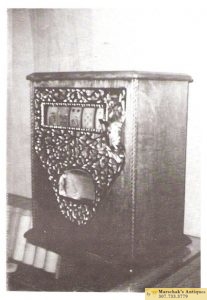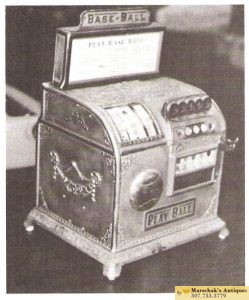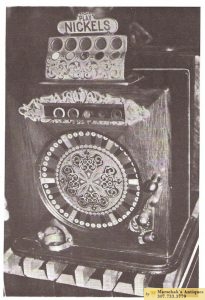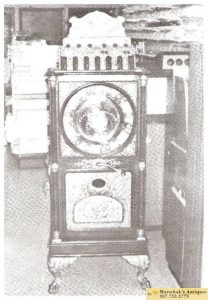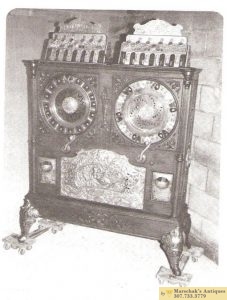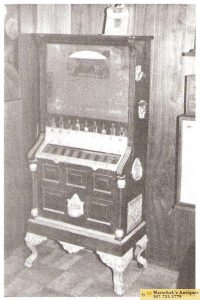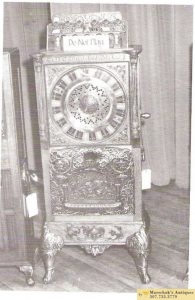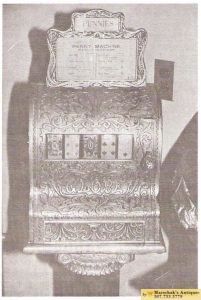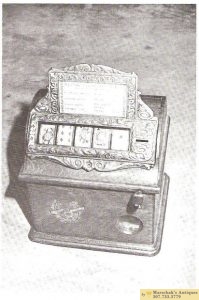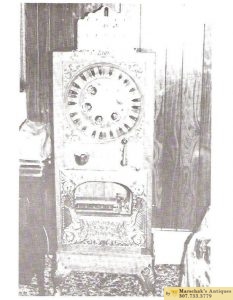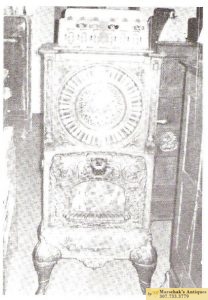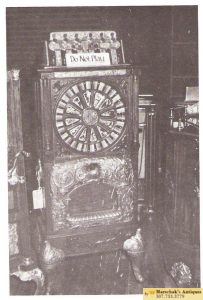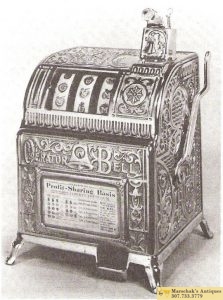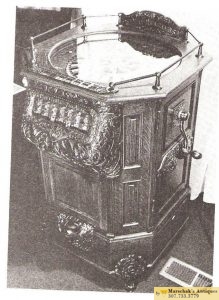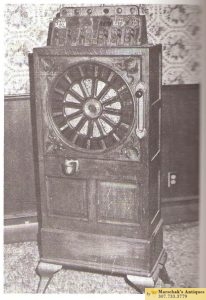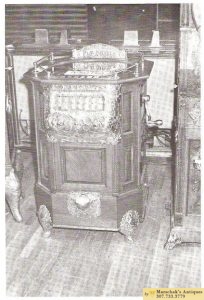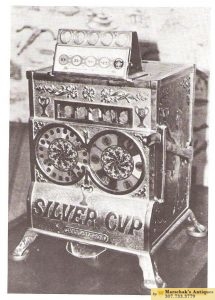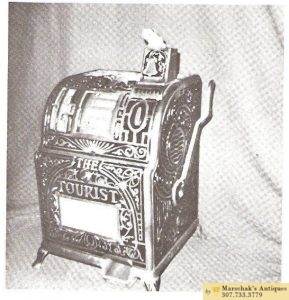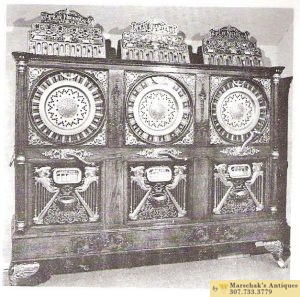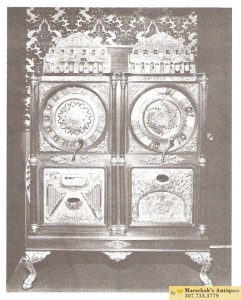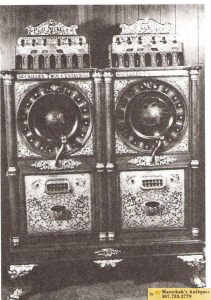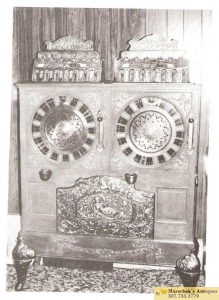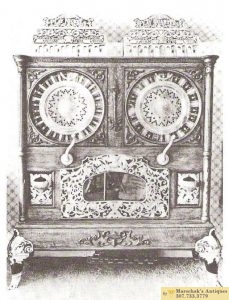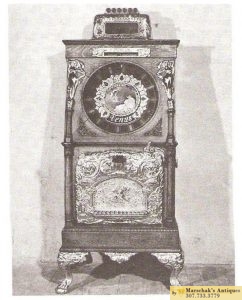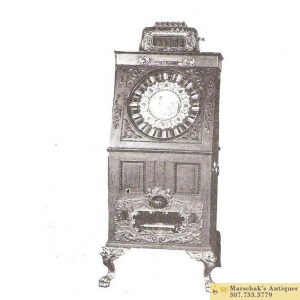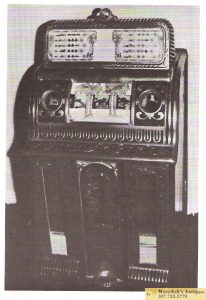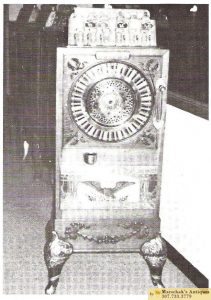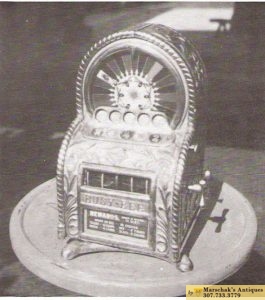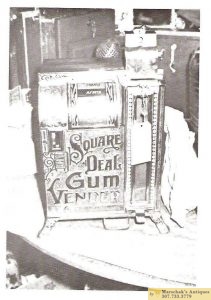Automatic Machine HULL’S CHICAGO Floor Wheel
Produced between 1903
“Who’s Hull?” Back in the late sixties and early seventies, when collectors first started talking to each other about their machines once they got over the idea that anybody they talked to would turn them into the local fuzz, the question kept coming up. It has ever since. It would appear there once was a company named Hull that made floor machines in the early 1900s. But things aren’t always what they appear to be.
The whole idea of a theoretical “Hull Novelty Company” came out of the fact that a number of surviving floor machines had original glass that pro-minently displayed the name “Hull.” The best known examples are the HULL’S CHICAGO, the latter pic-tured. One look tells you that this is an Automatic Machine And Tool Company machine. The cabinet, the castings, the crank coin head and the wheel are all but positive proof that the HULL’S CHICAGO and its compatriots were made in Chicago by the Automatic Machine And Tool Company. One by one the collectors that had the machines came to the same conclusion, particularly after they got a chance to see other machines made by the same manufacturer. One of the machines that surfaced in the middle sev-enties had a big “H” in the center of the glass–the same way John Gabel stuck in a “H” on his LEADER–to provide further similarities to Automatic Machine And Tool Company production.
But still the same question: who’s Hull?
The next assumption that gained favor was the possibility that Hull, whoever he was, was an opera-tor and had his glass made to special order. But that idea came a cropper when it was realized that the machines had shown up all over the country; in Cal-ifornia, the Dakotas, in Wisconsin and apparently one in Ohio. No operator had a territory that big. Then, to top it all off, one example showed up that had HULS (with one “L”) CHICAGO in the glass. Anyone named Hull wouldn’t accept that on a bet. That led to the assumption that the manufacturer was in charge of distribution and not a buyer named Hull.
Not one to back away from a puzzle the likes of this one, the author checked all possible machine makers or dealers in Chicago between 1899 and 1910 (even though John Gabel stopped making slot ma-chines in 1906), and only came up with three. There was a George H. Hull who worked as a machinist on the same block as the Mills Novelty Company in 1900, but not afterward. Then, between 1907 and 1906
1910, a guy named Cramford L. Hull sold stereop-ticons on the south side of Chicago. The best bet is 0. C. went to work for John Gabel, and got a chance to put his name on a machine or two of his own, spelled right or not. But even that’s only an assumption. So . . . who’s Hull?
Berger UNO Floor Wheel
There’s one thing about the UNO name on a slot machine that captures people’s imagination. They like it. And there’s something about UNO floor machines that captures collector attention. No two are alike. Half a dozen makers made UNO machines, and all they copied was the name. Cabinet and graphics-wise these machines differ from one another more than any other basic model automatic color wheel floor machine ever made.
So maybe the old makers liked the name, too. The UNO machines seem to suggest this. UNO floor machines were made big and small, plain and musical, expensive and cheap. Most of them were 5-way, and most were fairly expensive machines. But not the Berger. They made a cheapie in their basic Plain-Jane cabinet, substituting new glass only in a basic machine that also showed up as the Berger OWL and JUDGE. But don’t get swayed by this. Cheapie then — circa 1900 to 1902 — is valuable today, and this machine has a classic look all its own. The cabinet, while plain, is beautiful. The decals — in this example totally mint — are colorful and charming, and do a good job of taking the place of the expensive hand-carved trim of earlier Berger machines. That’s why decals were used; to take some of the high cost out of production so the machines could be competitively priced.
But what’s Berger doing with a mechanical machine, anyway? Didn’t they make the electrics? Sure they did, but by the year 1900 the mechanical floor machines based on the Mills OWL were running away with the market. So Berger, who still made the electrics, hedged their bets and came out with a low-cost line of mechanicals.
The basic cabinets, coin heads and mechanisms were the same. Only the glass changed. So this Berger UNO could just as easily have been an OWL, JUDGE, FOX, LION or STAR with different glass. Lucky for the collector that found this example in 1978 as the glass is UNO and there are no owls on the wheel. How come lucky? Well, out of the whole batch the UNO is preferred, and that’s the way it was found. Either the LION or FOX glass would have been almost as good, but UNO is still the top choice.
Here’s a neat aside. Back in 1901 when this machine was being widely advertised by Berger in THE NA-TIONAL POLICE GAZETTE, the selling price was $40. Look what’s happened since then. Berger also made the UNO MUSICAL that sold for very little more.
PRICE GUIDE
Condition Price Range Incomplete $1,500 to $2,500 Rough $2,500 to $3,500 Fair $3,500 to $4,250 Good $4,250 to $4,750 Excellent $4,750 to $5,500 Restored $4,500 to $5,000
Caille BANKER
Produced between 1906 cud 1916
You gotta have a gimmick! Back in the days when everybody was vying for the same business and all coin machine makers were pumping out new ideas by the dozens and storekeepers were beseiged by offers for machines that would do more for them – than any machine already on the market, it took more than having exactly what the other guy had to put a machine across. It took gimmicks, and lively salesmanship.
What the storekeepers wanted — if they wanted coin machines at all — was a rent-payer. So the profit performance of a machine came first. That’s where Caille Bros. had a gimmick in the BANKER Take a good look at the machine. If you can keep from being dazzled by the nickel-plated castings, the new name, and the other elaborate trim you’ll see it for exactly what it is — it’s nothing more than an UPRIGHT PERFECTION. But with Canda first, and then Mills and Kelley on the market with the same machine, Caille Bros. decided not to play me-too and took the route of salesmanship. The BANKER mech-anism is exactly the same one Caille Bros. used for the GOOK LUCK series (itself a renamed LITTLE PERFECTION), and the cabinet is the same as the UPRIGHT PERFECTION with the addition of elabo-rate trim so characteristic of Caille Bros. Literally, only the name is new.
BANKER came in four models, and examples of all of them can be found in collections. The BANKER line parallels Kelley’s THE KELLEY line, coming in either plain card, or card machine plus gum vender models. Caille took the machine a step further, pro-viding both models with or without a swivel base, with the stationary models having small rubber feet so that they wouldn’t scratch the counter.
The final sales gimmick was pure Caille. Names like UPRIGHT PERFECTION or THE KELLEY des-cribe the type of machine, or tell who made it. Caille elected to use a name that would help sell the machine and tell the shopkeepers what it would do for them; ergo, THE BANKER. Bankers, as we all know, make nothing but money. They sold a lot of them as the survivors testify.
PRICE GUIDE
Condition Price Range 7ncomplete Rough — .1- air Good Excellent Restored
$ 400 to S 900 $ 900 to S 1,200 $1,200 to S1,750 $1,750 to $ 2,000 $2,000 to $ 2,250 $2,250 to $2,500
Caille BASE-BALL
Good looks have a lot to do with the desireability and collectibility of an antique slot machine. Not all coin machines are worth thousands and thousands of dollars, even though it seems like they are. But the ones that look good are generally worth more than the others. In short, good looks often determine a value, often more so than rarity.
Then there are those machines that don’t look really bad, but frankly, ain’t no beauties. The Paupa And Hochriem ELK falls in this bunch for my money. It’s cast iron, exciting, mechanically clever and a coin machine classic that is akin to a mud fence. Then the BASE-BALL came along. Well, not exactly in that order. The Paupa And Hochriem ELK with its center-pull play lever became the Paupa And Hockriem right-pull play, to be picked up and copied by Mills, and then Caille Bros. and then Watling. At Mills, it also became the SPECIAL and a number of variations and over at Caille it became the TIGER and then spun off into a lot of TIGER, SPECIAL TIGER and export LE TIGRE models and by now the ELK had become a herd of other beasts and beings (not the least of which are the as yet maker-unidentified GOOSE and DUCK models.). They all have 6-way coin heads (except the French LE TIGRE, which has a 3-way, and the super-rare 5-way Caille SPECIAL TIGER with a side crank handle rather than the right front push lever) and they’re quite a bit alike. Until BASE-BALL.
The 5-way Caille BASE-BALL takes a different hit at things, and comes out of the box looking different and somehow nicer. It’s a penny machine and was made for cigar counters and ice cream parlors more so than the customary heavy-hitter saloon and pool hall locations. By 1911 and the teens soon to follow, the game of baseball filled out its shoes as The American National Game. It was bigger and even more popular then than it is now for there was little football and soccer had yet to rear its European head. Baseball was on everybody’s lips — and on candy and cigarette cards — and during the season robbed the headlines on the newspapers. Radio hadn’t yet come along as a public entertainment –it would take World War 1 and the immediate post-war years to accelerate its development and open the doors to commercial broadcasting — and television wasn’t much more than a theory. But poster printing was booming and most big cities had ball clubs easily reached by street cars. So the expression “Play Ball” was common (meaning “let’s get started”) and most people had a favorite team (for which they’d be willing to fight for, if someone insulted it).
61
So Caille made a beautiful nickel-plated adaptation of its SPECIAL TIGER called BASE-BALL with the words “Play Ball” on its front casting just below a cast iron baseball art element. New and colorful marquee, reward card and reel graphics make it a different machine. Payouts are in tokens from five payout tubes inside, spitting out checks worth 50 to 300. It was also made in nickel play, but the penny play model is the most prevalent. Even so, it’s a BASE-BALL only skin deep. Unscrew that cast iron baseball and you’ll find a tiger’s head. Keep digging and you’ll find other varia-tions. Industry Novelty Company (later to be O.D. Jennings) modified Caille BASE-BALL machines and put their own name on them, and Silver King in Indianapolis stuck their reward cards on Caille models to operate them. The model varieties are enough to field a whole team.
PRICE GUIDE
Condition Price Range Incomplete $ 600 to $1,500 Rough $1,500 to $2,500 Fair $2,500 to $3,600 Good $3,600 to $4,700 Excellent $4,700 to $5,500 Restored $4,700 to $5,000
Caille BEN HUR
Produced between 1908 and 1932
The Caille BEN HUR is a 5-way miniaturization of the upright automatic color wheel machine and its counter counterparts, such as the OWL JUNIOR. BROWNIE and the like. When Caille Bros. first intro-duced the machine in 1908 they called it the “small-est automatic money paying machine made”. Look-ing at it today, it doesn’t look so small, but when you compare it to an OWL or a BROWNIE you get the point.
It certainly was the smallest pluggable machine. True to the requirements of the day, the early BEN HURS have automatic percentage plugs behind the wheel. When the machine first came out it sold for S50 in nickel play and S60 in quarter play, going up ten bucks each in the teens. Perhaps the best looking small marquee in slot machinedom graces the top of many of the surviving BEN HURS, saying “Play Nick-els” or “Play Quarters”. This marquee has been re-produced in bronze, ready for plating, and has shown up on a lot of restored machines in spite of the fact that it is strictly a BEN HUR item.
Caille Bros. named the machine after the popular biblical novel by Lew Wallace first published in 1880. The book was so popular—the chariot race was just as exciting in print as it was in Technicolor four gen-erations later—that the story remained constantly alive in print, on stage and in the earliest movies well into the Twentieth Century.
BEN HUR was sold new well into the twenties, getting a new lease on life with an improved model introduced in 1928. It was the last of the automatic color wheel machines to retain its popularity on slot machine routes all over the country, and as a result examples are located almost anywhere. Most of the BEN HUR machines that collectors believe to be Vic-torian pieces were actually made in the late 1920s or early 1930s. By that time, the prices had doubled, with new BEN HURS selling for Sl 10. in nickel play and $120. in quarter play in 1928.
The BEN HUR is a marvelous looking machine with its natural stained wood cabinet and gilded wheel. In spite of its long popularity it is one of the most Victorian-looking machines that you can have in a collection. In its earlier models the cast iron trim could be had in nickel plate or oxidized copper. Most of the surviving machines are in nickel plate so the copper model is regarded as prime. ,There is no count of the surviving examples, but to judge from their collectible popularity somewhere between fifty and a hundred must be around. The number might
38
even go over a hundred if you count the non-collectors who have them in basement play rooms or bars, usually getting them as family heirlooms when they were saved after the dismemberment of Grand-pa’s drugstore or saloon.
Condition Incomplete Rough Fair Good Excellent Restored
PRICE GUIDE
Price Range
S 500 to $ 700 S 700 to $1,000 S1,000 to $1,400 S1,400 to $1,800 S1,800 to $2,300 S2,300 to $2,800
Callie BIG SIX
Floor Wheel
Produced between 1904
When anyone came up with a new machine name and format that sold, everyone else copied it. Well, the big manufacturers did. So when Watling came up with a machine called BIG SIX it wasn’t long before Mills and Caille Bros. followed suit. And wouldn’t you know, they all had the same kind of wheel. While most collectors feel the Watling BIG SIX is worth more. The reason seems to be the simple fact that it’s a Caille. For one thing, it’s rarer. For another Caille jazzed theirs up a bit by adding their fabulous drilled center disc, permitting a plunger to enter from the rear to stop the wheel. It’s clever. Finally, collectors of the truly elegant Caille machines are generally restricted to the ECLIPSE and CEN-TAUR, so it’s nice to have something different that matches.
It can almost be said that the BIG SIXES were the forerunners of the liberal slot machines of today. In a day when the wheels were plugged and percen-tage clips or “bugs” kept machine payouts low, the BIG SIX machines paid 5-for-1 on every color. All you had to do was pick the right one twice in six plays and you were money ahead. If you consistently hit one out of three or four you could make a bundle. For that reason alone, and the fact that the stop action was in full view of the player, the BIG SIX machines were regarded as the most honest of them all. The odds aren’t any worse than they generally are in Las Vegas or Reno today, with the Caille BIG SIX returning 83% of the handle to its players. The question seems to be why aren’t there more around? You would think that a machine this popular would have survived in much greater numbers than it has. Unless, of course, it’s very liberal stance made it un-popular with its owners and operators so it didn’t sell too well.
Speaking of selling well, there’s a very surprising twist to the story of the Caille BIG SIX. Caille Bros. produced it up until World War I, and then stopped. Twenty years later a machine rebuilding outfit in Providence, Rhode Island, bought up as many of them as they could find, fixed them up, and sold them as good-as-new machines. Their ad, appearing in the December 15, 1934, issue of THE BILLBOARD, had a nice picture of the old Caille BIG SIX floor wheel. The copy said: “Slot Operators. Good times are here again. Caille BIG SIX. 5/25/50 cent. An ideal machine for clubs, inns, taverns, road houses. An old timer, but a proven money maker. Rebuilt and thoroughly overhauled like new.” That would make the Caille BIG SIX the last and longest-lived floor machines to go on location. So where are they?
70
89116
If you feel lucky and want to track these down, look up the ad. Who knows, you might find a restored machine. Restored, that is, almost half a century ago.
PRICE GUIDE
Condition Price Range Incomplete $3,000 to $4,500 Rough $4,500 to $5,000 Fair $5,000 to $6,000 Good $6,000 to $6,500 Excellent $6,500 to $8,000 Restored $8,000 to $10,000
Caille BIG SIX-ECLIPSE TWIN
Produced between 1904
The biggest maker of TWINS, or TRIPLETS for that matter, was The Caille Brothers Company in Detroit. It was a Caille specialty. Lucky for us it was, for the Cailles are the flashiest machines in collectordom. Just look at this fantastic thing! It’s value as an antique reflects this desireability. In fact, everything reflects in it. There’s so much nickel plate on the cabinet, wheel faces and coin heads this machine must have almost glowed in the dark in any dimly lit saloon.
More than anything that’s what this machine is; a saloon collectible. Few of the larger and more professional antique price guides — the ones that cover any and all antiques and collectibles — list slot machines (or even coin machines, for that matter) as a separate collectible classification. But if you look under saloon collectibles you’ll find the old floor machines and, in the better guides, doubles like these. They are unique, big, beautiful and expensive. But so what! If you can afford one and want one you’d be nuts to pass it by for the simple reason that class tells. I can’t help but believe that no matter what happens to the collectibles market a good piece will always be a good piece and a good investment. A double like this sitting in the corner is like money in the bank at 15% interest. When other prices stabilize, as they say, a prime piece like this will always bring what the traffic will bear. I only wish I had been smart enough to see this years ago. But in the antique business — slots in particular– you can’t look back (or you’ll shoot yourself!). So if you’re into advice I just gave you some.
If you’ve followed these guides you know the Caille BIG SIX; it’s in Volume 2, Page 70. Ditto for the Caille ECLIPSE, Volume 1, Page 29. Put them all together and you spell awesome. This particular machine has been sitting in a collection for years, has the Caille serial 147 and a piece of paper dated 1909 inside the cabinet. The play is.25cr ECLIPSE and 50 BIG SIX but it could have been the other way around and was indeed preferred that way. Caille also made it in 25¢/50¢ play but I’ve never seen one. It takes a lot of reading of Caille catalogues and sales literature to get a real picture of what goes on here for the combination is tricky as hell. For some reason it was never all written up in one place. That in itself is reason enough for a slot paper collection for such printed knowledge is your only way of knowing what the machine itself can never tell you.
So here are some excerpts from Caille literature.
From Booklet M, 1912: “Great combination. ECLIPSE has percentage which plugs high colors when played and leaves them open when low colors are played. BIG SIX has no percentage but is a sure winner. Trimmings nickel, antique or Roman Gold. Casters on legs. Equipped with music if desired.”
and 1916
From Caille Catalogue 509, 1909: “The ECLIPSE is an extremely popular machine and when coupled to the BIG SIX the result in an irresistable combination machine that will get a big play in any location. Separately and together, as shown, these have stood the test and have always filled all requirements. The ECLIPSE has the automatic percentage regulator but has a “fixed” system that is always sure of making good. It is advisable to have ECLIPSE for nickels and BIG SIX for quarters.”
From Caille Price List 311, 1915: “BIG SIX ECLIPSE TWIN 50 and 250 play $295; 25¢ and 50(t play $330.”
From me: Wow!
Caille BULL FROG Floor Pocket
Things sure change fast in the field of antique slot machines. As these words are being written exactly two full years have passed since the volume 1. “An Illustrated Price Guide to the 100 Most Collectible Slot Machines” was published. Two years and six days to be exact. Yet in volume 1, under the description of the Mills CRICKET on page 31, these words are carried: “Caille Bros. made an almost exact copy of the CRICKET, coming out less than six months after the Mills model. They called it the BULL FROG. There have been a lot of rumors to the effect that collectors in Texas, Georgia, Minnesota and elsewhere have BULL FROG machines, but to date none have been confirmed”.
The ink was barely dry on volume 1 when the BULL FROGS began to show up. A collector in Utah had one all along. Then, before the year was out, one of the rumored BULL FROGS surfaced in Texas. In 1979, two more showed up in Wisconsin. So there are four confirmed, and maybe two more, or four more, if the rumors about Georgia, Minnesota, Northern Michigan and that same barn in Wisconsin are true. Instant inventory!
The most interesting part of these finds is that they seem to indicate that the BULL FROG was a line of machines, not just one model. Of the discovered models there seem to be two distinct variations — primarily, the coin heads are different — with both different than the BULL FROG machines depicted in the old Caille Bros. Co. catalogues.
The Caille BULL FROG, like the Mills CRICKET, is a super-overgrown coin drop. But what a drop! They are like enormous TARGET machines (see the trade stimula-tor volumes) with the added kicker of visible jackpots. If your coin goes into one of the proper holes the jackpot below it can be dumped by turning a handle and you get all the money you see. One interesting feature of the BULL FROG is the ability to regulate the payout percentages. You can set the jackpot gates practically shut so the player has a really tough chance at hitting a pot. If you aren’t careful you can tighten the payout off to zero, leaving you with a no-payout machine. Maybe the old operators did that, and maybe that’s why BULL FROG machines are rare.
The Caille has another unique distinction and that’s the origin of its name. Back in the early 1900s the motto “Watch us Jump” was known across the country. It was for a new gold mining town in Nevada named BULL
FROG. So when Caille made a payout floor machine with coins that jumped, they named it after the gold mine. There’s one thing about that original volume 1 description that did hold up. Comparing the Caille machine to the Mills CRICKET we said “Because of its rarity BULL FROG values, if such machines do exist, would be half again or even twice as high”. They are.
PRICE GUIDE
Condition Price Range Incomplete $ 5,500 to $ 7,000 Rough $ 7,000 to $12,000 Fair $12,000 to $15,000 Good $15,000 to $24,000 Excellent $24,000 to $28,000 Restored $24,000 to $26,000
Caille CENTAUR Floor Machine
Produced between 1907 and 1916
It is perhaps fitting that the last floor machine to be included as a prime collectible is the 6-way Caille Bros. CENTAUR, one of the richest looking and most colorful floor machines ever made. The CENTAUR is a direct development of the Caille ECLIPSE. Just as the Mills DEWEY had been developed into the DEWEY JACKPOT with the addition of a large glass covered jackpot over the payout cup, Caille Bros. modified their ECLIPSE to accomplish the same thing. They gave it the name CENTAUR which, while not as descriptive as using the word “jackpot” in the ma-chine identification gave it an aesthetic quality that was so often characteristic of Caille machines. The Centaur of legend was a man with a horse’s body and legs, in essence a mixture of two successful beings. So was the CENTAUR: It didn’t really matter though. Most buyers, with a pragmatic turn of mind, usually ordered the machine as the “ECLIPSE Jackpot”.
There are probably more CENTAUR machines a-round than DEWEY JACKPOTS, so it seems that Caille Bros. might have pulled out ahead of Mills in at least one area. Perhaps the answer lies in the con-struction of the jackpot feature. Many of the DEWEY JACKPOT machines are found with the jackpot win-dow smashed, suggesting that enthusiastic players found a more direct way to go home with the jackpot money. The Caille CENTAUR, on the other hand, put the visible jackpot behind bars, making it extreme-ly difficult to break into the coffers.
CENTAUR cabinets are a marvel of markmanship, with the natural stained wood finish offset by a vari-ety of great castings that were originally available in nickel plate, bronze or “Roman Gold”, a golden or-molu finish. In the latter case, the results are just short of garish, with the machine practically visually jumping out of a dark room.
The 1912 price for a CENTAUR was S180. in nick-el play; higher for quarter or half-dollar play, with each model S30. higher for music. Throughout its service life the CENTAUR sold for and was worth more than the DEWEY JACKPOT. The CENTAUR was also produced in an export model called GRAN PREMIO, or “Grand Prize,” a name that was retained by Caille for a later line of counter-top slot machines in the thirties.
37
PRICE GUIDE
Condition Price Range Incomplete Rough Fair Good Excellent Restored
S1,200 to S1,700 S1,700 to $3,500 S3,500 to S5,500 S5,500 to 57,500 S7,500 to S8,500 $8,500 to S9,500
Caille Eclipse 001
Produced between 1904 and 1916
The 6-way ECLIPSE is the crown jewel of the Caille Bros. line of floor machines. It was created as a direct competitor to the already successful Mills DEWEY and virtually paralleled the DEWEY line in modifications and advanced developments. There aren’t as many ECLIPSE machines around as there are DEWEY’S, but its large surviving population makes it the second most numerically important floor ma-chine collectible next to the DEWEY.
The ECLIPSE has a tube payout and a wheel with 92 spaces. There aren’t quite as many variations in the castings and the glass as there are with the DEW-EY, but quite a variety is known. Probably the most outstanding features are the castings which are rich in flowing robes, swirls, and detailed trim. But it’s the coin head that first catches the eye. It’s magnificent, and big. The Caille ECLIPSE was made in nickel, quarter and half-dollar models, all 6-way, with music available with any coinage as the MUSICAL ECLIPSE. In 1909, the machine sold for $120 in the nickel model; $150 with music. By 1912, the prices had gone up to $145 plain and $175 musical. CHECK ECLIPSE and MUSICAL CHECK ECLIPSE models were also produced, as well as twin and triplet models. Cabinets were natural stained wood with castings and trim available in nickel plate, bronze, or “Roman Gold”, the latter an artificial golden finish. Most of the surviving machines have been found in nickel plate with bronze running a far-away second, so it would seem that most ECLIPSE buyers were somewhat con-servative after all.
The Caille ECLIPSE was also the basic component for the best selling line of multiples in the industry. The ECLIPSE TWIN was generally available in two models, mixing 5 cent-play and 25 cent-play and, for the high rollers, 25 cent-play and 50 cent-play. In 1909 these machines sold for $250, and $280, re-spectively, plus $30. additional for music. By 1912, they were $300. and $335., plus $35. for music. ECLIPSE TRIPLET machines mixed nickels, quarters and half-dollars in a 600 pound device that sold for $480. in 1912, or for $520. with music. If you want a heartbreaker, a Duluth operator was selling ECLIPSE TWIN machines in 1946 for $150. to clean out his storage.
29
Caille ECLIPSE machines are distinctly different than virtually all of the other collectible floor ma-chines, as are the similarly trimmed Caille Bros. LONE STAR, FORTY-FIVE and later CENTAUR floor models. These beautiful machines almost draw a line between “Mills Collectors” and “Caille Collectors”. They do have one drawback for the uninitiated; they are devils to work on.
PRICE GUIDE Condition Price Range Incomplete $1,000 to $1,500 Rough $1,500 to $2,200 Fair $2,200 to S4,800 Good $4,800 to $6,500 Excellent $6,500 to S8,000 Restored $8,000 to $9,000
Caille globe 001
Things sure change fast in the field of antique slot machines. As these words are being written exactly two full years have passed since the volume 1. “An Illustrated Price Guide to the 100 Most Collectible Slot Machines” was published. Two years and six days to be exact. Yet in volume 1, under the description of the Mills CRICKET on page 31, these words are carried: “Caille Bros. made an almost exact copy of the CRICKET, coming out less than six months after the Mills model. They called it the BULL FROG. There have been a lot of rumors to the effect that collectors in Texas, Georgia, Minnesota and elsewhere have BULL FROG machines, but to date none have been confirmed”.
The ink was barely dry on volume 1 when the BULL FROGS began to show up. A collector in Utah had one all along. Then, before the year was out, one of the rumored BULL FROGS surfaced in Texas. In 1979, two more showed up in Wisconsin. So there are four confirmed, and maybe two more, or four more, if the rumors about Georgia, Minnesota, Northern Michigan and that same barn in Wisconsin are true. Instant inventory!
The most interesting part of these finds is that they seem to indicate that the BULL FROG was a line of machines, not just one model. Of the discovered models there seem to be two distinct variations — primarily, the coin heads are different — with both different than the BULL FROG machines depicted in the old Caille Bros. Co. catalogues.
The Caille BULL FROG, like the Mills CRICKET, is a super-overgrown coin drop. But what a drop! They are like enormous TARGET machines (see the trade stimula-tor volumes) with the added kicker of visible jackpots. If your coin goes into one of the proper holes the jackpot below it can be dumped by turning a handle and you get all the money you see. One interesting feature of the BULL FROG is the ability to regulate the payout percentages. You can set the jackpot gates practically shut so the player has a really tough chance at hitting a pot. If you aren’t careful you can tighten the payout off to zero, leaving you with a no-payout machine. Maybe the old operators did that, and maybe that’s why BULL FROG machines are rare.
The Caille has another unique distinction and that’s the origin of its name. Back in the early 1900s the motto “Watch us Jump” was known across the country. It was for a new gold mining town in Nevada named BULL
FROG. So when Caille made a payout floor machine with coins that jumped, they named it after the gold mine. There’s one thing about that original volume 1 description that did hold up. Comparing the Caille machine to the Mills CRICKET we said “Because of its rarity BULL FROG values, if such machines do exist, would be half again or even twice as high”. They are.
PRICE GUIDE
Condition Price Range Incomplete $ 5,500 to $ 7,000 Rough $ 7,000 to $12,000 Fair $12,000 to $15,000 Good $15,000 to $24,000 Excellent $24,000 to $28,000 Restored $24,000 to $26,000
Caille good luck 001
Produced between 1902 and 1916
Old “Round Top” rides again, only under a dif-ferent name this time. As vociferous as Mills, and fighting neck and neck with the Chicago producer to be the largest coin machine maker in the country, The Caille Bros. Company of Detroit also rapidly built their business and their line through acquisition and outright copying. When Canda sold off their chance and trade stimulator machines around 1901 in order to concentrate on arcade, picture and vending ma-chines, Caille picked up some of the same machines Mills did, as well as some Mills didn’t. The Caille touch was typical; in order to make the machines uniquely their own, they changed the names whereas Mills retained the names of their pickups. When made and sold by Caille Bros. the Canda CARD MACHINE became the Caille QUINTETTE; and the PERFEC-TION CARD the GOOD LUCK. Caille Bros. also changed the cabinet trim, adding castings and decals to create flashier machines, and as a result the Caille models are distinctive.
Caille started unloading the Canda stock of the small counter card machine in 1902 as the PERFEC-TION, soon calling it the GOOD LUCK PERFECTION. By 1902, with Caille production, the familiar machine was being sold as GOOD LUCK with the adjustable coin slot for penny, nickel, dime or quarter play. Caine called it the “most popular card machine ever built.” which indeed it is when you consider all the models by various producers.
Caille Bros. made a whole line out of the basic machine, and examples of all of them can be found in the hands of collectors. GOOD LUCK came in a countertop model as well as a swivel base model in either poker or “Figaro” numbered reel strips, with the card machine model the most numerous. A much more elegant swivel base version with a simulated in-laid wood cabinet and added trim was put on the mar-ket around 1905 as the GOOD LUCK SPECIAL, also available with playing card or numbers reel strips.
Caille sold the various “Round Top” GOOD LUCK models until World War I, leaving the business to Mills after the war. But in the early thirties the name came back when Caille Bros. made a five-reel modern all-metal ball gum counter game vender with poker sym-bols called GOOD LUCK. Strangely, the 1933 ma-chine is far rarer than the older wooden GOOD LUCK Card Machines of the past.
PRICE GUIDE
Condition Price Rance Incomplete $ 85 to S Rough $ 100 to Fair $ 200 to Good $ 350 to S -Excellent $ 400 to Restored $ 500 to S 75-IF
Caille lion 001
Produced between 1901 and
It’s fairly common historical knowledge among slot machine collectors, but a brief recap is in order. The Caille-Schiemer Company in Detroit, makers of floor machines, and The Caille Company in Detroit, also makers of floor machines, joined forces in July, 1901, to become The Caille Brothers Company when bro-ther Adolph Caille of Caille-Schiemer and Art Caille of Caille Company decided to simplify things and be a big company and make a lot of money. They did both, and for the next twenty years or so they and the Mills Novelty Company in Chicago were the two largest makers of slot machines in the country.
Back in the early 1900s and up until World War I, they were neck and neck, and based on the surviving floor machines around it’s hard to say who sold the most. The competition survives today, but in the antique field. Some slot enthusiasts are dedicated Caille (meaning Caille Bros. Co.) collectors, while others are Mills freaks, with everything else falling in between, or outside of, depending on how you look at it.
Whatever Mills did, Caille matched, and vicey-versy, so if there was a cheap, 5-way Mills floor ma-chine (which there was in the JUDGE!) there was a Caille model to match. And the model was the LION. Sure, Caille-Schiemer and later Caille Bros. made a JUDGE selling new for less than a hundred dollars, the Caille’s reacted in kind with their LION.
The LION was originally made by Caille-Schiemer. so when the two firms got together the LION was one of the first machines made under the Caille Bros. Co. banner. Elsewhere in this book you’ll find the first full page ad run by The Caille Brothers Company, and if you look close enough you’ll find the LION in both the “plain” and “musical” models. Caille Bros. Co. called their machine the “King of all five way play getters.” In later years, at the end of the production run and after they had hyped the coin head to prevent cheating, Caille said: “While we do not recommend 5-slot machines we recommend the IMPROVED LION as being the best 5-slot produced. It is cheap in price only.”
So why should a “cheap” machine be so valuable? Because it’s so damn good looking and because it’s so rare, that’s why. The photographed machine is the original MUSICAL LION from 1901, including an eight tune swiss music box. Music adds a lot of value to a floor machine, and when good looks go with it the price goes off the top. Just imagine what a TWIN LION would be worth if one could be found. Caille made ‘ern and sold ’em in 1905.
Condition Incomplete Rough Fair Good Excellent Restored
1906
PRICE GUIDE Price Range
$4,500 to S6,500 $6,500 to 57,500 $7,500 to S9.000 $9,000 to S10.000 $10,000 to S12300 $12,500 to S15_000
Caille MUSICAL PUCK
Produced between 1900 and 1916
If you know your Shakespeare you know that Puck was the mischievous young hobgoblin that kept pulling pranks in the comedy A Midsummer Night’s Dream. He got everybody all screwed up. In a way the Caille PUCK — with a big floor slot machine life second only to the Mills DEWEY— did the same thing. When somebody says they’ve got a PUCK, or a MUSI-CAL PUCK, the more you know machines the more you wonder what they’ve got.
Caille-Schiemer came out with PUCK as the first 6-way machine, in a tall skinny cabinet with bathtub type cast iron legs, as we have seen. In August 1899, a Swiss music box was added below the wheel so that the machine could be run in closed towns. A “Musical Cabinet” nameplate was screwed on to the cabinet. The musical feature didn’t work too well, so at the end of the year, barely making its appearance in Jan-uary, 1900, Caille-Schiemer replaced it with an im-proved model in which the music could by turned on and off, and called it the IMPROVED PUCK MUSI-CAL CABINET. While all this was going on Art Caille, younger than brother Adolph of the Caille-Schiemer Company by four years and much more promotion-minded, formed his own The Caille Company in De-troit, and in 1900 was making — you guessed it — the PUCK, in both “Plain” and “Musical” models in a somewhat different cabinet. By the next year, the two Caille brothers came to the conclusion that they were running off in too many directions, so they got together and formed The Caille Brothers Company in Detroit in July, 1901, with their first model — guess which one? The PUCK and MUSICAL PUCK. The cabinet and castings were changed again. Jacob Schiemer and Robert Yates, both involved in The Caille-Schiemer Company, weren’t part of the deal, so they formed their own Schiemer-Yates Company in Detroit the same year, and started making their own PUCK machines. The only way to tell these models apart is to check the castings and any paper inside the machines. Caille-Schiemer machines have “C-S” cas-tings; Caille Company has “The Caille Company” on its castings and paper; The Caille Brothers Company has “C-B” or “Caille Bros.” castings and paper; and Schiemer-Yates machines have “S-Y” castings. The long-term survivor was Caille Brothers, making musical PUCK machines in a variety of cabinets, castings, and colors for many more years. If all that isn’t confusing enough, a dozen other producers copied the PUCK name. So if somebody asks you “What’s a PUCK?”, sit them down for a long conversation.
PRICE GUIDE Condition Price Range Incomplete $1,000 to $1,800 Rough $1,800 to $3,500 Fair $3,500 to $5,500 Good $5,500 to $6,500 Excellent $6,500 to $8,000 Restored $8,000 to $9,000
Caille NEW CENTURY
Produced between 1901 It was as easy to proliferate models way back when as it is today. Back in the forties and fifties we used to add the word “super” to everything to mean a later, improved or larger model. Evidenced are the old World War II Boeing FLYING FORTRESS and SUPERFORTRESS bombers. Post-war Bally and Keeney slot machines added words in much the same way. Witness the Bally DRAW BELL and the later DELUXE DRAW BELL. In our own day, there’s the “Mark II” anything, and the beginning usage of ex-pressions about “21st Century Technology.” We’ve come full circle, proving that people never really seem to change. Well, their things do; but their basic thinking doesn’t.
SO go back to the early 1900s. You could make a new machine or a new model of an old machine and call it the “20th Century Something.” Mills copped the name fast for their brand new TWEN-TIETH CENTURY floor machine, so Caille Bros. was caught cold. They’d get killed if they put “20th Century” on an upgrade, so they picked another pop expression of the day for their re-makes of 1901, batting out “New Century” machines. The richly decorated NEW CENTURY DETROIT was a lot better looking than the old slab cabinet Caille-Schiemer and later Caille Bros. DETROIT, so it got the new name. The amazing fact is that they were selling the old and newer models at the same time, and you’ll find all four–the DETROIT and NEW CENTURY DETROIT, both in “plain” and “music” mdoels–in the Caille Bros. ad reproduced elsewhere in this book.
The Caille NEW CENTURY DETROIT is one of the classiest machines you can own, and for that rea-son it tends to be worth more than a lot of equally good looking machines. Rarity has a lot to do with this, as there are far fewer NEW CENTURY DETROIT machines around then DEWEYS and NEW CENTURY PUCKS among others.
The DETROIT and the NEW CENTURY DE-TROIT are akin to the Mills ON—THE—SQUARE in that the stopping action can be seen from the players’ side. But the Caille creation is a lot spiffier. See the holes on the disc in the center of the wheel? Well, what happens is that there’s a hole for each color, and when the wheel stops a plunger pokes its way through one of the holes with the appropriate color paying off provided You played it. It’s a heck of a mechanical thow_ Caille got competitive in their ads, say:- “z-,=:Teral 1:-_-_:_tadons of this machine have been a ratchet wheel on outside but the it fools nobody, making this NEW _ _ DEIROIT, by Caille, of course!) zetters_-
and 1905
PRICE GUIDE
Condition Price Range Incomplete 84,000 to $4,500 Rough $4,500 to $5,500 Fair $5,500 to $6,500 Good $6,500 to $7,500 Excellent $7,500 to $8,500 Restored $8,500 to $9,000
Caille NEW CENTURY PUCK
If you thought that we had run out of collectible PUCKS, you’ve got another think coming. Actually, the NEW CENTURY PUCK models and their succes-sors, made by The Caille Brothers Company in De-troit, are the best known and most highly collectible machines in the PUCK series, and carried the PUCK name to the end of its production history. The name “New Century” meant the advent of the Twentieth Century and was in great vogue for virtually every-thing the moment December 31st, 1899 turned into January 1st, 1900. For the next two or three years the expression got to be as over used and boring as the tag lines of our lifetime, such as “Space Age”, “Computer”, and other handles that have been stuck on product names. Caille Bros. completely reengi-neered and redesigned the 1898 PUCK mechanism, glass and cabinet to make the machine more com-petitive with the Mills DEWEY, sticking the play lever on the front. It was the beginning of the char-acteristic elaborately trimmed casting and cabinet look that would make Caille machines stand out for years to come. The new color-coded coin head and heavier legs makes the machine look bigger and strong-er than the earlier models. The mechanism is also easier to work on, as the filigree parts of the earlier models are replaced with components that are heavier, simplified and fewer. The new machine carried a nameplate saying THE NEW CENTURY PUCK, with original iron castings in either nickel plate or antiqued copper. Nickel and quarter models were produced and later a half-dollar model.
One of the great features of the newer PUCK is that the more the machine is used, provided the parts aren’t worn out, the better they run. A musical model was produced as THE NEW CENTURY MUSICAL PUCK which has nine-inch cylinder music box play-ing eight different short selections. In fact, the top PUCK collectible is this machine with its original mu-sic. As the years went by, the straight and music mo-dels became known as the CENTURY PUCK and the CENTURY MUSICAL PUCK, available in “plain” or the more elaborate cabinets. By 1906 or so the “New Century” name had been dropped and the machine once again went on to its destiny as PUCK, getting flashier in its old age with a bright green painted cabi-net, and in some cases, ormolu castings. Many collec-tors, believeing that richly rubbed natural grain wood-en cabinets offset by the patina of antique nickel-plated trim are the norm are sometimes shocked by the painted PUCKS. But that’s the way they were.
PRICE GUIDE Condition Price Range Incomplete $1,200 to $2,000 Rough $2,000 to $4,500 Fair S4,500 to $6,500 Good $6,500 to $8,000 Excellent S8,000 to $8,500 Restored $8,500 to $9,500
Caille OPERATOR BELL
You’re looking at the king! Of all of the cast iron cabinet “Iron Case” Bell machines of the 1906-1916 period — with the exception of the original Fey LIBERTY BELL, of course — this is the one collectors want most. One look will tell you why. The machine you’re looking at hasn’t been restored; it’s just been cleaned. It’s Caille OPERATOR BELL serial 4,566 (the serial number is die stamped on the front at the bottom, just to the right of the payout cup) and only the second such machine to be found.
As late as July 1977 no Caille OPERATOR BELL machines were known. It was assumed to be a “lost” machine, although collectors knew that quite a number were made as a variety of cast iron models were catalogued and advertised between early 1911 and 1916. But where were they? Literally, the whole country was looking. In the middle of that hot climate of anticipation your author had all but given up on ever finding anything again. It was the steamy summer of 1977 and the date was Friday, August 19th. Worse, even if I found something I couldn’t do anything about it — I had thirty bucks in my pocket and a holiday weekend to get through. I had been at a client sales meeting in Menasha, Wisconsin and had to give the ad agency advertising presentation late Thursday night, then drive for ten hours all the way around Lake Michigan to join my family in Shelby, Michigan the next day. One of the client salesmen said: “Don’t drive. Take the boat over. They book reservations months ahead, but I’ll bet you get in on stand-by”. So at 7:00 A.M. on Friday, I pushed the car half way across the state to Manitowoc, got to the boat by 10:00; was first on the waiting list and had an hour to kill before we sailed at 11:00. What to do for an hour? Actually, only 45 minutes as I’d need 15 minutes to get my car on the ferry and buy a ticket. So zip into town to check antique shops. There were three; only one was open. Nothing. By 10:15 the second one opened. Interesting stuff, but nothing. So I drove back to the boat at 10:35, and passed shop No. 3. Open. Nothing. I asked the lady if she had any “vending machines or coin machines”. No answer. I started out the door at 10:45. Late. Half way out she said, “We had one, but we sold it”. I asked; “When?” She said, “Next week”. Next week? I said, “Do you still have it?” She said, “Yes, but it’s too late. We have an offer on it”. I said, “Can I see it”, expecting a Mills “Hightop”. She said “Sure”, and took me into the basement. In a far corner, under a throw rug, was a lump. Sticking out of the corner was a nickel-plated cast iron foot. My heart stopped. It was 10:49. I was sure it was a Mills “Iron Case”.
She pulled off the rug. Caine! Keys and all. She asked, ” What do you think of it?” I slowly, unemotion-ally said, “That’ s….nice”. She asked, “Well, will you make an offer?” I didn’t answer. She said “Make me an offer!” I asked, “What’s been offered so far?” She said, “Oh no, I won’t play that game and get chiseled. Make me an offer!” My heart stopped again. Thirty bucks in my pocket. 10:52! So I said, “Okay. Eight hundred”. She said, “It’s yours”. So I shook her hand, promised to be back with money in three days, raced to the boat, got on as the last-call whistle blew and sat for six hours going nuts as we plowed across the lake. On Tuesday, August 23rd I was back with the money. She was a lady of her word, and the first and oldest Caille OPERATOR BELL yet found was in my station wagon. The serial is 3,210 and the castings are marked “Caille BDL” for “Caille BELL DELUXE”. Since then at least three more have been found.
PRICE GUIDE
Condition Price Range Incomplete $ 2,500 to $ 4,000 Rough $ 4,000 to $ 8,000 Fair $ 8,000 to $10,000 Good $10,000 to $11,000 Excellent $11,000 to $14,000 Restored $11,000 to $12,000
Caille PEERLESS Floor Roulette
PEERLESS is its name. Peerless is its fame. And fortune, because that is what it’ll take to own one of these machines. As it stands today, this is the top of the line in slot machine collecting. There are rarer ma-chines — a lot of one-of-a-kinds. There are even more valuable machines — whatever the Caille PEERLESS is worth an original Fey LIBERTY BELL would go for at least 20% more these days. But if you’re a “Major Collector” (that’s usually anyone that owns any form of early 1900s automatic payout roulette floor machine) this’ll be the machine you brag about.
It was never any different. Even back in 1978, when the first volume of this series of price guides was printed, the Caille ROULETTE and Fey LIBERTY BELL were neck-and-neck in value (see pages 30 and 33 of Volume 1). Volume 1 featuied the Caille ROULETTE, an 80-pocket 7-way automatic payout roulette floor machine first made in 1904. This time around we’re featuring the Caille PEERLESS, a T-way 60-pocket machine of 1907 that has major mech-anical improvements over the earlier model. Both machines are of currently equal value rank, but the PEERLESS is a bit more fool-proof in its play.
As originally delivered, both of these machines had an elaborated trimmed, silvered and gilded glass with the Caille Bros. and machine name on it. But you can just imagine how long that lasted as a flat glass top that people leaned on to watch the play. El Cracko! Even the short nickel-plated fencing around the covered wheel designed to protect the glass from abuse didn’t solve the problem. In a way it created one. The old saloon players yearned to set their steins on the top of the machine but couldn’t because of the rails. So players and observers balanced their brews in their hands, and often dropped bottle, beaker, whiskey glass or schooner smack dab in the middle. As a result, most of the surviving machines are already on their third or fourth glasses, by now crystal clear sans graphics. A few of the original have survived the years and will probably be reproduced in quantity to bring all the other old machines up to snuff, but to date the generally missing glass graphics don’t seem to have hurt the values a great deal.
The way the PEERLESS works is astounding. Little fingers below each pocket await the reception of the free spinning ball. If the ball falls into a pocket for which the color has been played — there are seven possibili-ties: Black pays 2, Red 2, Yellow Crescent 4, Single Star 10, Double Star 14, “0” pays 20, and “00” pays a whopping 40 — the payout is automatic, from 10(C to
$2.00 on the nickel machine and 50(C to $10.00 on the quarter machine. Caille called the PEERLESS “The only large successful roulette made” adding that “This machine represents years of careful study and work”. It shows it.
Caille also made a CHECK PEERLESS model that had an extra payout cup and dispenser for trade checks. Only two of them are known. Caille listed the standard PEERLESS in its 1915 Catalogue 311 as a”Discarded Machine”, selling them off at low prices. That doesn’t seem to have worked, because they were back in a Caille catalogue and direct mail flyer in 1921. Seems they had a hard time unloading them. They wouldn’t today.
PRICE GUIDE
Condition Price Range Incomplete $15,000 to $18,000 Rough $18,000 to $25,000 Fair $25,000 to $30,000 Good $30,000 to $45,000 Excellent $45,000 to $55,000 Restored $40,000 to $45,000
Caille PUCK Floor Machine
Produced between 1898 and 1901
In the slot machine business it was always impos-sible to keep a good idea to yourself. It wasn’t long after the Mills OWL began to run away with most of the sales in the industry that a company half a mile away began to crank out a similar machine with a 6-way coin head. The first PUCK was made by The Illinois Machine Company at 147 Fifth Avenue, (now it’s called Wabash Avenue) in Chicago early in 1898. Adolph Caille and Jacob Schiemer from Saginaw, Mi., already in the store and saloon fixtures business, formed the Caille-Schiemer Company in Detroit to make the machine and take over a big piece of the booming gambling machine business.
Where the OWL had a crank on front, the PUCK had a heavy push-down wooden arm. Instead of a 5-way coin head, with a top payout of a dollar, the PUCK could take up to six coins with double the top payout. The result was instant success, and led to the same form of flattery Mills’ experienced; everybody else started making PUCKS.
It was on July 15, 1898 that Caille-Schiemer star-ted using the name PUCK on their machines, even getting a registered trademark for the name and logo style. If you want to frame one on the wall behind your machine look up trademark 32,567 issued on March 7, 1899. The machine name was taken from a popular humor magazine called PUCK WEEKLY to pick up on an already well-known name, and to sug-gest that the machine was fun to play.
It’s fairly easy to tell the early PUCK machines apart. The Illinois Machine Company model has the lettering “IMCO” on its front casting while the Caille-Schiemer version has “C-S” all-over it, inside and out. There are quite a number of surviving early PUCKS around, with the Caille-Schiemer model outnumbering the Illinois Machine Company version by about four-to-one. They face the same problems the OWLS do; the coin heads are often cracked or missing. If the head is cracked, the problem can be solved, but it takes a careful welding job. Missing heads are a bigger problem as there’s not enough to go around. Some-times a correct head will cost almost half as much as a machine, but if you want a complete machine it’s worth the money, otherwise you’re stuck with an “Incomplete”. Someday, someone will make a good business out of recast and properly machined repro-duction coin heads. As of now, it hasn’t been done, at least not in volume.
The PUCK is the oldest form of six-slot floor ma-chine made. It was also the first popular floor ma-chine to sport a music box in its PUCK MUSICAL CABINET model of 1899.
PRICE GUIDE
Condition Price Range Incomplete $1,000 to $1,200 Rough $1,200 to $3,200 Fair $3,200 to $5,000 Good $5,000 to $5,500 Excellent $5,500 to $6,000 Restored $6,000 to $7,000
Caine ROU- E Floor
Produced between 1904 and 1922
The Caille Bros. ROULETTE has been called “The King of Slot Machines” because of its desireability and its mechanical action. It was the first antique slot to sell at auction for over $10,000. which in the middle seventies was regarded as a magic number that once hit would indicate that slot machine collecting had come of age. There was little doubt that some slot machine would sell for that astronomical figure some day. The question was which one? In 1975, in Las Vegas, a Caille Bros. ROULETTE was sold from the block for $11,250. to set the record. A lot has happened since then. There are quite a number of roulette floor machines in the hands of collectors. At the time of the 1975 auction a dozen were known, and at least five or six have surfaced since then. Most of them are 7-way 5 cent or 25 cent-play Caille Bros. PEERLESS machines, mechanical marvels that free-throw a ball into a spinning roulette wheel with sixty pockets. Once the ball stops in a pocket the machine makes an automatic payout of from two to forty coins. The PEERLESS is a 1907 development of the earlier Caille Bros. ROULETTE of 1904, a similar machine with an eighty pocket wheel that was plagued with mechanical problems. The Caille ROULETTE in turn was based on the Mills ROULETTE, the first popular all-mechanical roulette floor machine, mak-ing its appearance in 1902. Mills popularized the genre in a 7-way eighty-pocket machine available in 5 cent or 25 cent-play in a beautiful six-sided cabinet. It had its problems, so the machine was redesigned and reissued in 1904. Only four, perhaps five, of the Mills machines are known to exist. Mills also made a ROULETTE MUSICAL, but none have been found. Typically, the Caille roulettes are more elegant and virtually drip with plated castings. Caine also solved some of the access and repair problems by producing a larger eight-sided cabinet for both its ROULETTE and PEERLESS machines. The PEERLESS was sold longer than most collectors realize, with Caille Bros. still producing and promoting it as late as 1922. Watling also made a ROULETTE, starting in 1904, that was an eighty-pocket duplicate of the first Caille models. None have been found. But the theoretically rarest roulettes all no longer exist in memory, or even in pictures. They are probably the ones that inspired The Mills Novelty Company to come out with their own version in the first place. MARSHFIELD ROU-LETTE was a nickel play machine introduced in June, 1900 by the Marshfield Novelty Company of Minne-apolis, and the Foss Novelty Company in Cleveland made one in 1901. Find one of those and you can set your own price.
PRICE GUIDE Condition Price Range Incomplete $5,000 to $7,000 Rough $7,000 to $8,000 Fair $8,000 to $10,000 Good $10,000 to $12,000 Excellent $12,000 to $20,000 estored $20,000 to $25,000
Caille SILVER CUP Counter Machine
Produced between 1912 and 1917
Perhaps the greatest asset the gambling machine industry of the early 1900s had going for it was the imagination of Charlie Fey. Sitting at the workbench in his San Francisco shop with new, old, unfinished and recently modified slots of all kinds and surroun-ded by a small army of young boy apprentices to run the routes, do the hard metal filing, and generally learn the coin machine business from the ground up, Fey batted out machine after machine, with just about every idea brand new.
Fey created the 5-way cast iron SILVER CUP around 1910 or so, as an advance development of an earlier machine he made called THE DUO, and ran it on his routes in nickel and quarter play. Boldly displayed in its cast iron case was the name “Chas. Fey & Company”. Two or three of the machines are known, with one of them un-earthed as late as 1977.
Fey must have made some sort of deal with Caille–by that time Charlie Fey and Adolph Caille were old buddies—because Caille Bros. came out with the same cast iron machine around 1912, with the only visible change in the front casting nameplate. Now it said “Caille-Detroit”. No one else made anything like it. Caille also made a side vender model called SILVER CUP VENDER. Until the early nineteen-seventies only two or three of the Caille models were known to exist. But in a blaze of discovery another four or five suddenly came out of the woodwork in as many years, and they keep showing up. No venders yet, but who knows what’s out there? Caille also made a similar machine called LOVING CUP, including a vender model. Not to be outclassed, Mills jumped on to the double-dial idea by converting its BROWNIE into a two disc machine, splitting the power drive of the wooden-boxed DOUBLE DIAL BROWNIE mech-anism to spin two smaller color wheels. The idea apparently didn’t take hold, and only one of the ma-chines survives. So far, that is! By 1915 Mills had given up on this direction and was selling the machine as the SILVER CUP. Not to be out-done, Mills also converted its CHECK BOY cabinet into a SILVER COP, sticking two color wheels on top of the already massive cast iron cabinet. None are known.
Caille SILVER CUPS retained a long. period of active use. There was an active market for used and rebuilt machines for operators in the early 1930s, and SILVER CUPS may well have run on location until World War II. Why not it’s a great looking little machine, and a lot of fun to play.
PRICE GUIDE
Condition Price Range Incomplete Rough Fair Good Excellent Restored
S 800 to $1,200 S1,200 to $4,000 $4,000 to $5,100 S5,100 to 56,250 $6,250 to 57,500 S7,500 to $9,000
Caille TOURIST Counter Single Reel Produced between 1912 and 1916
Does it seem logical that a single reel counter ma-chine made after 1912 can be worth a lot more than a substantial number of the older color wheel floor machines? It certainly is to the collectors that favor the Caille TOURIST, and one look at the machine will go a long way to telling you why this is so. The problem is, it’s difficult to see.one as they never seem to make it to the open market. This is a machine that is traded and rarely sold. Apparently only two or three of them are known to exist. There might be more, because it is the kind of machine that “secret” collectors like to hide.
In appearance the Caille TOURIST is splendifer-ous. It’s cabinet is an exact match to the Caille OPERATOR BELL of 1913, the only difference be-ing that the TOURIST is a single reel machine while its counterpart has three reels. Both of the machines are heavily nickel plated, and literally glow in the dark once they are cleaned up and polished. The heads, sides, backs and feet are practically duplicates, and side by side the two machines look like twins. But there the similarity ends, for the TOURIST is completely different from a Bell in concept. It works practically the same way as the Eagle SQUARE DEAL GUM VENDER. The single reel has 31 spaces, divvied up into five countries: United States, Ger-many, Ireland, England and France. Some countries have more reel stops than others, permitting a variety of payouts of from 2 to 20 coins. The player sets the lever at the color for the country he wants to play for when the coin is dropped. Pushing down the coin plunger at the top and pulling the handle locks the selection and the reel spins. Hit a winner and the coins spit out just like a regular three-wheeler. It’s a terrific show.
It’s interesting to know that the Caille TOURIST was a collectible before any example of the Caille OPERATOR BELL had been found. Looking at old catalog sheets didn’t reveal the fact that the two ma-chines were so much alike; it took the discovery of an OPERATOR BELL to make the point. Hopefully more TOURISTS can be found. Caille also made it with city symbols in place of countries, with the selections including Detroit (where Caille was, of course), Boston, Toronto, Chicago and Denver. Both versions were also made with side venders. But the real treasure, if it can ever be found, is the cabinet vender model. It had a music box in the cabinet.
PRICE GUIDE
Condition Price Range Incomplete $5,000 to $5,500 Rough $5,500 to $6,000 Fair $6,000 to $7,000 Good $7,000 to $8,000 Excellent $8,000 to 59,000 Restored $9,000 to $10,000
Callie MIXED TRIPLET Floor Machine
Produced between 1903 and 1916
Speaking of “Triplets!’, there is a group of ma-chines that are available in some numbers, although their trading prices belie their existing population. The whole idea of a double or triple floor machine was to get around the growing tax laws and slot ma-chine licensing fees. With a double or triple you could get two or three machines licensed for the price of one. When music was added, the customer always got something for their money, win or lose.
There are more Caille triplets around than any other kind, suggesting that Caille Brothers made most of them, probably because they did a good selling job in putting them over. A few Watling and Victor triples also survive, but the big trading is on the Cailles’. In the early seventies only five Caille triplets were known to exist. Since that time, more have been found at the rate of about one every two years. Most of the surviving examples are Caille MIXED TRIPLET machines, both plain and musical, in which a variety of Caille floor machines of the same basic size are joined together. A typical mix consists of Caille CENTAUR, ECLIPSE, and LONE STAR machines in 5 cent and 25 cent play, with nickel play models at each end, although these were generally later models made after 1907. Earlier triplets mixed PUCKS in 5 cent, 25 cent and 50 cent play models, while later triplets included the CENTAUR TRIPLET, ECLIPSE TRIPLET and a variety of MIXED TRIPLETS.
The Caille triplets are nowhere near as large and heavy as their Mills and Watling counterparts. A Caille MIXED TRIPLET weighs in at around 600 pounds and is sixty-two inches wide. According to the Mills catalogue sheets the DEWEY TRIPLET was eighty-five inches wide and nine inches taller than it’s Caille Bros. competition. That may be another reason why the Caille models were more popular. A typical re-action to advance notice of a police raid on resorts or saloons with gambling in the early 1900s was to turn the face of the floor machines to the wall. Moving 600 pounds was probably tough enough; but 900 pounds, that’s all but impossible. The sheer bulk of the triplet machines suggests you won’t find them in attics or basements. They probably never left the ground floor, and that’s just where most of them have been found.
PRICE GUIDE Condition Price Range Incomplete 55,000 to $7,000 Rough 57,000 to $10,000 Fair S10,000 to $18,000 Good S 18,000 to $28,000 Excellent $28,000 to $32,000 Restored 532,000 to $37,000
CailleTWIN Floor Wheel Produced between 1911 and 1915
A number of Caille “doubles” were covered in Volume 3 of this series of books, with the TWIN DETROIT of 1903-1916, TWIN ECLIPSE of 1904-1916 and TWIN CENTAUR of 1907-1916 getting the treatment in its pages, all highly rated for their elegance. But here comes the capper, the Caille Bros. TWIN of 1911-1915. What makes the TWIN different is the fact that it is made up of two different machines.
Caille “doubles” are rated as the prime double-machine collectibles. It’s their flash and detail that makes this so. Never let it be said that Caille couldn’t take the same class of machine made by half-a-dozen other makers and gussie it up so completely that its owners and players thought they were working something completely different than the competition offered. The casting details are so excessive and the appointments so lush that the Caille floor machines almost looked bathed in light even when they were hiding in the dark corner of some old pre-prohibition saloon. There was always enough flickering light to make a Caille visible. This was doubled when two machines were put together as one. The result was even greater flash covered by one tax stamp.
Caille’s standard “double” was two models of the same machine with different coinage, usually stepping a nickel up to a quarter for modest players and heavy-hitters alike. Playing two-bits on a single spin of the wheel back in 1912 must have been scary because it was a lot of money then. But the step up from nickel play to quarter play was easy and comfortable as both machines in the same cabinet were generally alike. It was just a matter of moving a little bit to the right, taking the bigger coin out of your pocket and going for it.
But not the Caille TWIN. It wasn’t two of a kind at all; it was two diverse machines of the same frame size, and often of higher denominations. Generally, the base machine was Caille CENTAUR or ECLIPSE at the left and a more unique machine at the right so players could move from the conventional and comfortable to a higher risk or more complicated machine. The models were seemingly endless, with CENTAUR-ECLIPSE TWIN, CENTAUR-BIG SIX TWIN, CENTAUR-LONE STAR TWIN, ECLIPSE-BIG SIX TWIN and even LONE STAR-FORTY FIVE TWIN and BIG SIX-LONE STAR TWIN models known. Caille Bros. sometimes catalogued these machines as MIXED TWINS and even had “THE CAILLE TWINS” glass on some. They were all offered in both plain and musical models, the latter having only one music box, left or right, to avoid conflicting tunes.
The machine shown here is a Caille Bros. CENTAUR-BIG SIX TWIN in ” Quarters” (CENTAUR) and ” Half Dollars” (BIG SIX) play, making it a big money machine
indeed. At the time this photograph was taken around 1968 by the late Dan Adams the machine was owned by Roy Arrington, subsequently to be auctioned. The detail and condition is marvelous. The jackpot model CENTAUR is covered on Page 37 of Volume 1, although the jackpot, front castings and coin head on this CENTAUR differ considerably from that earlier version. The BIG SIX is covered in detail on Page 70 of Volume 2, with cabinet, castings and coin head identical in both models.
There is another interesting point about this machine. The CENTAUR at the left uses the elaborate MUSICAL CENTAUR front castings, yet no music box had been fitted. A similar 25(/50 machine in the Jonas Silber-stein collection— it may even be the same one– carries the serial 120/2-3-45. The Caille Bros. Catalogue 509 of 1909, describing the CENTAUR-LONE STAR TWIN, provides an insight into the location popularity of the Caille TWIN machines when it says; “The leading operators admit that ‘Twins’ will take in more than three single machines and we have seen this demonstrated time and time again. Operators must have them.” Time has proven the point in an altered manner, for today a Caille TWIN is still worth more than three single machines.
Caille TWIN CENTAUR Floor Wheel
Double your pleasure. Double your fun. And more than double your value. Here’s a super hot collectible that until now has never been touted in print. In fact, floor machine “Doubles” have been sadly ignored with none appearing in either of the first two volumes of the “An Illustrated Price Guide to the 100 Most Collectible Slot Machines” series. But we’re making up for that in one big rush in this volume with four doubles in one presentation. And there’s more coming up in later volumes, so we can meter them out in print now that we’re caught up.
The Caille TWIN CENTAUR is…gorgeous! The only thing that tops it out is the Caille MIXED TRIPLET described on page 27 of Volume 1 in this series. Actually, that’s a misnomer, for the machine illustrated in Volume 1 is really the Caille CENTAUR TRIPLET, with all three machines in the cabinet sporting CENTAUR jackpots. So here it is in a double as the TWIN CENTAUR, and showing off something you rarely see on a Caille TWIN. Look at the cast iron and nickel plated nameplates above the wheels on the cabinet. They both say “Caille’s TWIN CENTAUR”, a point of detail missed on many of these machines and one that hypes the value of the examples that carry it. All the things that make Caille collectors drool over their machines are here, only doubled. The elaborate coin head, fantastic wheels, and unmatched front plates. There’s quite a bit of variety in these machines as they were made long enough to mix and match and modify their parts and trim.
The dating of the Caille TWIN CENTAUR is fairly precise, something that can’t be said for a lot of floor machines. The intelligence comes out of the 1909 The Caille Bros. Co. Catalogue No. 509 which does a good job of describing the machine, to wit: “This fine machine has been on the market only about a year and has met with a very large sale. The jack-pot feature is an attraction that is sure to take and persons who ordinarily do not play will be induced to try their luck. The pots fill automatically after a winning is made. An automatic percentage device, similar to that of the ECLIPSE, is embodied in the CENTAUR and has proved a great feature because of the Jack Pots. Cabinets can be had in quartered oak or mahogany finish. We furnish the ornamental parts in nickel plate, Roman Gold (Note: To date collectors don’t know what that color is as it doesn’t seem that any of the so-called Roman Gold-plated machines have survived the years) or Antique ( Second note: this is assumed to be antiqued copper).
Poking around old catalogues tells us other interesting things. A 1915 Caille price list No. 311 quotes the TWIN CENTAUR at $375 for 54/250 play and $405 for 250/500 play. But the interesting item was the “Discarded Machines” list that says that “Twin ma-chines equipped with music box” would no longer be available, thereby precisely dating the time when the major makers discarded music for floor machines. Incidentally, the values below are for the MUSICAL TWIN CENTAUR Without music, subtract $3,000 across the board.
PRICE GUIDE
Condition Price Range Incomplete $ 8,500 to $12,500 Rough $12,500 to $18,000 Fair $18,000 to $20,000 Good $20,000 to $24,000 Excellent $24,000 to $27,000 Restored $24,000 to $25,500
Caille TWIN DETROIT Floor Wheel
As long as we’re on the subject of twins machines (most collectors call them “doubles”) lets keep the wheels spinning with that idea for awhile. These are machines that hardly anybody sees unless you’re a “friend of the collector” or something. They don’t move around the country much because they’re just too big to move a lot. Finally, their written history and pictorial record is scant because most of them seem to be in the hands of “secret collectors”. You’ve got to remember that just a little over four years before this writing it was illegal to own an antique slot machine in every state of the union except Nevada. The fact that thirty states have legalized antique slot machine ownership since then (the exciting story of this collector movement is carried in detail in volume 2) hasn’t affected the doubles much. Their owners, for the most part, got them when they were illegal and have just kept them ever since. Therefore, if you’re a slot machine historical nut you can’t just go out and look for the doubles; they’ve got to find you!
That singular fact of life put your author on “doubles duty”. Everybody was asked “Who’s got a double?” and once that was determined a trip to see the actual machine was made, or the owner was asked to send a photograph. And oh how the doubles rolled in. There’s a lot more doubles out there than you’d guess, and the variety is as surprising as hell. We won’t plop them all in this volume —but we will throw in enough to give you an idea of the variety of this genre.
The Caille TWIN DETROIT is just about the oldest form of double we’ve run across. The DETROIT is an exposed-stop variety of the Caille PUCK named after the home city of Caille Bros. Co. products (just as the Mills CHICAGO is an exposed-stop version of the DEWEY and named after its home city). At least two examples are known. This model in the hands of an anonymous collector and has an enormous casting over a covered area that could be used for a music box. A second MUSICAL TWIN DETROIT model was sold at auction at Harrah’s in June, 1975.
Caille made the machines in 5(C/250 play, as this PRICE GUIDE
example is, and in 25(C/50(P play. None of the higher denomination machines are known.
Condition Price Range Incomplete $ 5,000 to $10,000 Rough $10,000 to $14,000 Fair $14,000 to $17,000 Good $17,000 to $22,000 Excellent $22,000 to $25,000 Restored $22,000 to $23,000
Caille TWIN ECLIPSE Floor Wheel
The Caille floor machines are probably the ones most collectors across the board want the most. It’s the trim, castings, colors and carvings that make them the things of beauty that they are. They don’t look as utilitarian as Mills machines do, as weird as the Watlings, or as potently plain as most of the off-brand models. The Cailles have a distinctive sit and vista. In short, they’re smashing.
That claim to fame goes double for doubles, and redoubles for music. So you’re looking at a super prime machine. And its always been that way. Caille TWIN ECLIPSE machines were collectibles long before slot machine collecting was a fad. In fact, the man that had the first slot machine collection, if you can believe those in the know and old coin machine industry hands, had a TWIN ECLIPSE. His name was Alden Scott Boyer and he had a small cosmetic chemicals company on the near south of Chicago in the 1930’s and 1940’s. In a write up on the Boyer collection (you’ll learn a lot more about Boyer and his collection in volume 5 of this series) in the March 1940 issue of AUTOMATIC AGE, one of the two major trade publications of the coin machine industry when slot machines were in their prime, the TWIN ECLIPSE was mentioned. In an article entitled “Another Group of Boyer’s Old Timers” they said “Of particular interest….is the Caille twin console. Mr. Boyer….was so impressed with the beautiful woods used in the cabinet of this machine that he cheerfully spent about one hundred dollars to enhance the original appearance by having the cabinet rubbed and polished and having all external metal parts re-plated in gleaming, lustrous bronze”. Imagine that! A restoration for a hundred bucks! Everything was a lot cheaper then.
This characteristically pre-collection boom naive approach to TWIN ECLIPSE values hung around a lot longer than you might suspect. As late as 1971 antique columnist Joel Slater, in his copyrighted column “An-tiquing With Joel Slater”, wrote; “Caille Double, originally with music, 1906 (is) valued at over $2,500 and can be seen as part of the decor at The Handlebars Saloon, Pasadena, California”. By 1975, at the Harrah’s auction, a TWIN ECLIPSE went for $5,600, and by the time of Roy Arrington’s 5th Annual Victorian Casino Antiques auction in Las Vegas in February, 1978, one went for $37,500. From $2,500 to $37,500 in seven years? What other form of investment has appreciated that fast? The values are somewhat stabilized since then, and the prices for a musical model at current values are shown. For a “standard” model, sans music, subtract 10%.
PRICE GUIDE
Condition Price Range Incomplete $ 6,000 to $11,000 Rough $11,000 to $15,000 • Fair $15,000 to $20,000 Good $20,000 to $27,500 Excellent $27,500 to $30,000 Restored $25,000 to $27,000
Caille VENUS Floor Wheel
Here it is, the top of the slant front line, and the quintessence of Caille collecting to many “Advanced Collectors” (If you ever wondered what that meant when you saw it in ads or auction lists, it means people with a lot of money that are willing to drop a big chunk of it on a single piece) across the country. Part of the super turn-on of the VENUS is the over abundant plated trim, particularly the lightly draped ladies above the columns on the front.
VENUS is a VICTOR, plus. The glass is almost the same, only now the Caille name has been clearly added, as well as the VENUS name on both the glass and nameplate. Both VENUS and MUSICAL VENUS models were made, with the “Plain” VENUS shown with pricing for the musical model. Current values are the same for both VICTOR and VENUS, yet the VENUS is the preferred model. You can get approx-imate current values for both without music by sub-tracting $3,000 from each listed price range.
Alden Scott Boyer of Chicago, the first true slot machine collector (Long dead! Machines dispersed!) had a VENUS back in 1940. He said, in the February 1940 issue of AUTOMATIC AGE, that the “VENUS 6-way color wheel machine (was) manufactured by Caille Brothers in 1897”. That started the dating screw up. It wasn’t straightened out until Catalogue No. 509 of the Caille Bros. Co., dated 1909, was discovered. In it, at last, was the VENUS, with some interesting comments about the machine. Caille calls it “A six Slot — The only single nickel or quarter machine. Adjustable for either nickels or quarters”. That’s a pretty unique comment, so the catalogue goes on to explain: “The VENUS is a decided departure in slot machine construction. Besides being the original bevel cabinet (Note: Aha! They weren’t called slant fronts. They were “bevel fronts”), it is the only machine that can be changed in a few minutes into a 25-cent play or vice versa (i.e. back to nickel play). But another reason why we designed the VENUS (Note: Pure puffery. They didn’t design it; Schiemer-Yates did!) was to have a machine with a cut-out that throws out one coin at a time. In all the preceding machines in this catalogue (i.e. the Caille-designed machines.) the coins are cut out in lump sums. This is approved by our patrons, but the VENUS principle serves to satisfy those who prefer the single payout method. The coin detector of this machine is also different from any other. It has a shutter which closes the coin chutes when the front is unlocked. No chance to rob it. Nickel and quarter play (Note: Only one basic model for both coins. Neat.) $135.00″.
So that’s what makes the Schiemer-Yates and Caille machines so different! The convertible playing coin feature, the one-at-a-time payout mechanism and the anti-stealing lock and shutter. Then your author had a hunch. If Caille Bros. made both the VICTOR and VENUS were they advanced developments of the GIBSON GIRL, or were they picked up from Schiemer-Yates whole cloth? So I had a number of VENUS owners take a close look at their machines to check their castings. Some were standard “CB” with the Caille Bros. Co. name all over them. But two VENUS machines — one in the John Herman collection in California, and a second found in Louisville, Kentucky by Pete Hansen of Illinois — have “S-Y” castings. Schiemer-Yates! So we have three possibilities: one, Schiemer-Yates made the VENUS first; two, Caille Bros. sold VENUS machines originally made by Schiemer-Yates; or three, Caille Bros. used up old “S-Y” castings on their VENUS production. More likely it’s all of the above.
PRICE GUIDE
Condition Price Range Incomplete $10,000 to $12,000 Rough $12,000 to $15,000 Fair $15,000 to $20,000 Good $20,000 to $25,000 Excellent $25,000 to $30,000 Restored $25,000 to $27,000
Caille VICTOR Floor Wheel
Shades of Schiemer-Yates! Back up four pages and compare this Caille VICTOR with the Schiemer-Yates GIBSON GIRL. Now if they just ain’t like two peas in a pod. Same basic cabinet with frilly wooden trim and corner insets, right down to the lower front castings, legs and coin head. These machines are just short of look-alikes and run-alikes. If it wasn’t for the VICTOR nameplate, the unique glass, and the fact that the wooden trim and cabinet panel work is slightly different you’d swear that this was a Schiemer-Yates machine. Hold that thought for a while; we’ll get back to it on the next page. When the first slant front Caille VICTOR showed up years and years ago — known examples were in the hands of a few pioneer slot machine collectors even before the 1960s — it was thought to be a very early example of a Caille Bros. Co. floor machine, and dates like 1897 were freely quoted. At the time it was thought that the slant front came before the tall, straight-up-and-down floor machines. It wasn’t until historical tracking by the author at the end of the 1960s revealed the fact that The Caille Bros. Co. wasn’t formed in Detroit until July 1901, that a previous company called The Caine- Schiemer Company started making a machine called the PUCK on July 15, 1898, and that yet another company called Schiemer-Yates Company was formed at the same time The Caille Bros. Co. was founded with both Schiemer-Yates and Caille Bros. Co. making the PUCK (Are you lost yet? It gets confusing. This whole historical track is explained in greater detail on pages 14 and 19 of Volume 1 in the “100 Slots…” Price Guide series) that the idea that slant fronts came first was blown sky high. So, if the slant fronts weren’t first, went the popular logic, they had to be last. That led to a lot of thought-to-be knowledgeable comments that the slant fronts (by that time yet another Caille slant front called the VENUS — it’s described next — had been recognized) were the last floor ma-chines made by Caille as the final and ultimate development of the automatic color wheel. The truth of the matter is hardly as glamorous as that. The real answer is that they came in the middle. Where they came from wasn’t known until the fairly recent discovery of the Schiemer-Yates GIBSON GIRL. In one lucky find a collector came up with a truly unique machine, and taught the rest of us that the 1907 acquisition of Schiemer-Yates by The Caille Bros. Co. gave Caille its slant front line. With that bit of knowledge everything else falls in place, so you can see that the machines themselves can often tell us a lot if we know what we’re looking for and how to use the information.
Caille made the VICTOR in both “plain” and MUSICAL VICTOR models, with the musical version shown and priced. Back in 1969 an antique dealer in Lexington, KY put a plain VICTOR on the market for $1,000 and took months to unload it. One of the dumbest things I ever did was pass it at that price because I thought it was too high. In November 1977, at the famous Kruse Auction of the S.H. Mitchell collection, conducted on a mountaintop in Vesta, Virginia, a VICTOR minus its legs went on the block at $11,000 and people thought the buyer was nuts. Like a fox! That machine taught us something, too. It carries a red decal that says: “B. Sicking. Manufacturer of Slot Machines. 1931-1933 Freeman Ave., Cincinnati”. A lot of people thought it was a Sicking machine — some still do — but obviously Sicking jobbed it as a distribu-tor or ran it on his own routes. The small detail of that decal confirmed the dating of the VICTOR at 1907, because that’s the first year Sicking ( See the first “Blue” volume of “An Illustrated Price Guide to the 100 Most Collectible Trade Stimulators” for more details about the Sicking Manufacturing Company in Cincinnati) started to use the double-number address.
PRICE GUIDE
Condition Price Range Incomplete $10,000 to $12,000 Rough $12,000 to $15,000 Fair $15,000 to $20,000 Good $20,000 to $25,000 Excellent $25,000 to $30,000 Restored $25,000 to $27,000
Caille VICTORY Bell Machine
Produced between 1920 and 1925
You have to be pretty sharp of eye and keen of wit to tell the difference between the Mills, Caille, and Watling Bell machines of the late teens and early twenties. They all have their distinctive qualities, but once the oak cabinet came into fashion, the ma-chines began to look a lot alike. The Great War, that early and optimistic name for World War I, had a lot to do with it. Mills started the oak cabinet in 1915, Caille Bros. in 1916, and Watling by the end of the year. 1917 was a non-production year, because Amer-ica was at war, with the 1918 Mills OPERATOR BELL looking a lot like the 1916, only it had a redesigned mechanism. To help identification out, each year for a decade most of the Mills machines had the. model year in the front casting. By then, Watling machines looked like Mills machines, and a bunch of new post-WWI producers made similar Bells.
Only the post-war Caille Bros. machines looked different, and how! Caille had a hard time getting back into production after the war. Losing momen-tum and trying to break away from the pack and come to grips with the staggering head-start competi-tion from Mills, Caille Bros. tried a trick. By that time, the Bells had a ten year history of side handles. So Caille put the pull in the middle. They did it by attaching an upside-down “U”-shaped piece of steel to the handle shaft on the right side and added a bearing on the left. A handle was welded to the center of the bridge with the shaft coming out of the front of the machine at the top of a tall pull slot. No other Bell before or since was put together the same way. The machine had a modest success when it came out, but not nearly the success it now has over half-a-century later. Because it is so different from other Bell machines it is regarded as an eminent col-lectible.
Caille called it the VICTORY model, then a pop-ular expression because of the victory of the Allied Powers of England, France, Italy, America, Japan, and the others over the Central Powers of Germany, Aus-tria – Hungary and Turkey in The Great War of 1914-1918. Two basic models were produced: The VIC-TORY BELL, with an elaborate cast iron cabinet front on an oak case showing lightly clad women in swirling robes; and the VICTORY GUM VENDER holding packaged gum in vending columns. By 1923, the VICTORY BELL, was being called the OPERATORS BELL — because that’s what everybody else called their straight gambling Bells — and the vender model had been redesigned to hold rolls of mints in two vending columns instead of gum.
A variety of reels — specifically fruit, fortune and card symbols — were used on the machines. By then, the Vender was called simply VICTORY and was known as the “Victory Mint Vender” or “Victory Counter Vender”. The machine was being sold until the end of the twenties, later models having cast alu-minum fronts. Some examples of all models are known.
PRICE GUIDE
Condition Price Range Incomplete $ 400 to $ 800 Rough $ 800 to $1,200 Fair $1,200 to $2,200 Good $2,200 to $3,000 Excellent $3,000 to $4,500 Restored $4,500 to $5,000
Caille- Schiemer DETROIT
Floor Wheel
Produced between 1898 and 1901
If you’ve studied the history of slot machines at
all you probably know that the first popular mechan-
ical floor model automatic color wheel machines were
the 5-way Mills OWL and the 6-way Caille-Schiemer
(out of the Illinois Machine Company) PUCK, both
brought out in 1898. After that, whooshl All sorts
of people jumped into the act and mechanical floor
machines were being cranked out by the bunches.
You’ll see soon, for this volume touches on a lot of
these machines from the well-known to the oddball.
This brief review of floor machines will also prove
a point: to the winner goes the spoils. The fact
that the Mills Novelty Company of Chicago was first
in the field, and The Caille-Schiemcr Company of
Detroit was a hot second, literally made the future
of both companies. Ever afterward, for the next
third of a century, the names Mills and Caille were
the big ones in the business. When Caille conked out
in the depression, Mills even kept that top rank for
another third of a century after that.
These two big outfits got that way because they
started out with a good machine, and then added to
it. Both Mills and Caille pumped new models into
their line as fast as they could once it was obvious that
their first floor machines were off and running. Sud-
denly, the slot machine business was a tale of two
cities, with Mills and a growing list of imitators in
Chicago facing Caille-Schiemer and a smaller but sim-
ilar cadre of copy-cats in Detroit. Even the city names
ultimately had meaning to the slot machine buyers.
If a floor machine was made in Chicago it was pre-
sumed to be a practical, hardworking device prob-
ably made by Mills. . .and the price was right. If it
was made in Detroit it was probably very ornate with
a lot of decoration and trim and was made by those
Caille fellows. . .and cost more.
The Caille-Schiemer Company went right along
with the act and revamped their PUCK to create a
new 6-way machine called the DETROIT, adding a
new feature that had a lot of player appeal. As
Caille described it in their catalog: “The pay-wheel
of a DETROIT actually stops dial and causes the pay-
out works to operate. On account of the DETROIT
being the original machine showing the paywheel in
full View of the players, it became known far and
wide as ‘Honest John’. Everyone believed it could
not be plugged whereas it actually has a percentage
regulator of unique design that is only found on the
DETROIT machine.”
Caille-Schiemer BUSY BEE
Produced between 1899 and 1916
The BUSY BEE introduced what would become
one of the leading names in the slot machine industry
to the field of trade stimulators. The Caille-Schiemer
Company of Detroit started out by making the PUCK
automatic color wheel floor machine in 1898, adding
the countertop BUSY BEE trade machine the next
year. Looking like a roulette wheel the disc of the
BUSY BEE spins Vertically giving it the appearance
of a miniaturized color wheel in a highly omamented,
nickel-plated cast iron cabinet. BUSY BEE is 5-way
play, permitting the player to pick a color to win
2, 5, 10 or 20 cigars for a nickel, with red, black,
green, yellow and the “Busy Bee” having the same
reward rates as a larger floor model 5-way color wheel.
When Caille-Schiemer dissolved and the Caille Bro-
thers Company was formed in Detroit in the summer
of 1901, BUSY BEE became a Caille Bros. machine,
continuing in a series of follow-on developments.
Caille Bros. BUSY BEE NO. 2 is a 3-way machine
for penny play, with players getting 3 cigars on white,
2 cigars on yellow and 1 cigar on green, or just
losing outrigit. The apparently good chance of win-
ning a nickel cigar for a penny kept up the play, with
Caille advertising saying that “one of these little ma-
chines on your counter will sell as many cigars as a
salesman back of your counter,” not mentioning the
fact that the salesman had to be there anyway to
make good on the winners
Probably the best seller was BUSY BEE N0. 4,
a 5-way nickel play machine that gave at least one
cigar for every nickel played, with a chance to win
a total of 2, 3 or 4 cigars on each play. It§promo-
tional literature claimed that “the use of one of these
trade stimulator machines will stir up your business
to a degree you cannot appreciate until you actually
get one,”
BUSY BEES are regarded as classic cast iron pieces.
As such, they command high collector prices, with
the Caille-Schiemer models regarded as the most
valuable.
Produced between 1899 and 1916
The BUSY BEE introduced what would become
one of the leading names in the slot machine industry
to the field of trade stimulators. The Caille-Schiemer
Company of Detroit started out by making the PUCK
automatic color wheel floor machine in 1898, adding
the countertop BUSY BEE trade machine the next
year. Looking like a roulette wheel the disc of the
BUSY BEE spins Vertically giving it the appearance
of a miniaturized color wheel in a highly omamented,
nickel-plated cast iron cabinet. BUSY BEE is 5-way
play, permitting the player to pick a color to win
2, 5, 10 or 20 cigars for a nickel, with red, black,
green, yellow and the “Busy Bee” having the same
reward rates as a larger floor model 5-way color wheel.
When Caille-Schiemer dissolved and the Caille Bro-
thers Company was formed in Detroit in the summer
of 1901, BUSY BEE became a Caille Bros. machine,
continuing in a series of follow-on developments.
Caille Bros. BUSY BEE NO. 2 is a 3-way machine
for penny play, with players getting 3 cigars on white,
2 cigars on yellow and 1 cigar on green, or just
losing outrigit. The apparently good chance of win-
ning a nickel cigar for a penny kept up the play, with
Caille advertising saying that “one of these little ma-
chines on your counter will sell as many cigars as a
salesman back of your counter,” not mentioning the
fact that the salesman had to be there anyway to
make good on the winners
Probably the best seller was BUSY BEE N0. 4,
a 5-way nickel play machine that gave at least one
cigar for every nickel played, with a chance to win
a total of 2, 3 or 4 cigars on each play. It§promo-
tional literature claimed that “the use of one of these
trade stimulator machines will stir up your business
to a degree you cannot appreciate until you actually
get one,”
BUSY BEES are regarded as classic cast iron pieces.
As such, they command high collector prices, with
the Caille-Schiemer models regarded as the most
valuable.
Clawson AUTOMATIC DICE
Produced between 1890 and 1902
A throw of the dice is as American as a shot and
a beer, and saloon patrons imbibed almost as often
as not by playing against the barkeep. It was stand
ard barroom fare, until the bartenders got fed up with
the constant customer demand for a game for drinks.
Clever inventors provided new solutions, with dice be-
coming the first chance paraphernalia to be mechan-
ized. Clement C. Clawson, an early coin-operated
platform scale maker of Newark, New Jersey, created
a sophisticated and mechanically complicated coin-
released dice thrower which he called AUTOMATIC
DICE, forming The Clawson Slot Machine Company
to manufacture the device. AUTOMATIC DICE was
introduced in 1890, quickly finding favor as the first
nationally popular coin«operated gambling machine,
making The Clawson Slot Machine Company the first
nationally—known producer of slot machines, with the
company name literally giving the machines their class
name.
To this day one marvels at the workings of AUTO-
MATIC DICE. Dropping the nickel starts a pre—wound
clockwork mechanism that brings two dice cups down
over matching trays holding three dice each, with the
whole assembly then rotating backward with the trays
serving as the cup lids. Then, with a quick throw the
trays go flat again, and the cups throw the dice back
on the trays. And that’s it! The player counts the
spots, with the total indicating a win or loss based on
a reward card tally, with the bartender paying off in
drinks. The marvel of it is that you see it all happen
before your eyes, wheel-spinning clockwork mechanA
ism and all, as the entire operation takes place be-
hind clear glass.
AUTOMATIC DICE was also made later as AUTO-
MATIC FORTUNE TELLERin which the reward card
theoretically told fortunes by the total spot numbers,
a subterfuge to get around anti-gambling laws. A
typical AUTOMATIC FORTUNE TELLER serial is
527X. Six to ten of these Clawsori dice machines are
known to exist, with newly found examples showing
up in 1976 and 1977. The rarest variant is the AUTO» PRICE GUIDE
MATIC SALESMAN of 1893 which automatically
pays out a winning token, but to date there are no C0f1dl'(l0n Price Range
surviving examples of this model. Other producers Incomplete $ 800 to $1,400
imitated the machines, including the M. 0. Griswold Rough $1,400 to $3,200
And Company DICE and the Weston Slot Fair $3,200 to $5,500
Machine Company variation made in Syracuse, New
York, that used small ball hearings in rotating twin Good $5500 to $6’000
pinfields instead of dice. But it’s the Clawson that Excellent $6300 to $6200
most collectors seek. Restored $6,200 to $6,500
Eagle SQUARE DEAL GUM VENDER
Produced between 1911 and 1922
Remember how the McDonald Manufacturing Com-pany became the Victor Novelty Works and then Victor became something else? Well, they became the Eagle Manufacturing Company, and the guy that engineered the deal was a genius type slot machine inventor named Thomas V. Skelly. It was just about the time that the three-reel Bell machine (given its machine class name by Charlie Fey’s LIBERTY BELL as reported in the first volume of these collector guides) was sweeping the business and cast iron ma-chines on short feet were all the vogue.
The first machine produced by the Eagle Manu-facturing Company was a 6-way counter wheel pay-out called the EAGLE, so you can see where the company name came from (just as Victor’s VICTOR named Victor). A gum vending version was made as the EAGLE GUM VENDER to get around anti-gam-bling laws. Then, when the single and multiple reel machines got popular, Eagle did the same thing with a tall gum package vender called SQUARE DEAL GUM VENDER. The size–it is deceptively large–bulk, bright colors and elaborate front castings made this one of the most sought after counter machines known to collectors.
Only three or four of these machines are known to exist in various stages of condition. What most of its owners don’t realize is that while it is decidedly a payout machine it was never intended to pay its winners in cash. The original literature for the ma-chine describes it as “a combination trade check and gum machine allowed by authorities everywhere.” So, you play money, get a package of gum if you pull the slide, and get a payout in tokens if you win. The way to win is to select a color by a lever before you play, picking one of five. Shades of the Victor LITTLE SIX AMERICA WINS; the colors correspon-ded to countries, only this time any country could be a winner with “America” having just as much a chance as any other. A typical serial number is 30.
By way of a social note, although it came out only a few years after the Victor LITTLE SIX AMERICA WINS it reflected a change in the labor pool. America, Germany, England and France were there as they had been in the past, but Sweden and Ireland were obviously lumped with America to make room for a new addition, a generic and geographic lumping identified as “Africa.”
PRICE GUIDE
Condition Price Range Incomplete $3,000 to $3,500 Rough $3,500 to $3,750 Fair $3,750 to $4,000 Good $4,000 to $4,500 Excellent $4,500 to $5,500 Restored $5,500 to S6,000
Caille-Schiemer BUSY BEE
Produced between 1899 and 1916
The BUSY BEE introduced what would become
one of the leading names in the slot machine industry
to the field of trade stimulators. The Caille-Schiemer
Company of Detroit started out by making the PUCK
automatic color wheel floor machine in 1898, adding
the countertop BUSY BEE trade machine the next
year. Looking like a roulette wheel the disc of the
BUSY BEE spins Vertically giving it the appearance
of a miniaturized color wheel in a highly omamented,
nickel-plated cast iron cabinet. BUSY BEE is 5-way
play, permitting the player to pick a color to win
2, 5, 10 or 20 cigars for a nickel, with red, black,
green, yellow and the “Busy Bee” having the same
reward rates as a larger floor model 5-way color wheel.
When Caille-Schiemer dissolved and the Caille Bro-
thers Company was formed in Detroit in the summer
of 1901, BUSY BEE became a Caille Bros. machine,
continuing in a series of follow-on developments.
Caille Bros. BUSY BEE NO. 2 is a 3-way machine
for penny play, with players getting 3 cigars on white,
2 cigars on yellow and 1 cigar on green, or just
losing outrigit. The apparently good chance of win-
ning a nickel cigar for a penny kept up the play, with
Caille advertising saying that “one of these little ma-
chines on your counter will sell as many cigars as a
salesman back of your counter,” not mentioning the
fact that the salesman had to be there anyway to
make good on the winners
Probably the best seller was BUSY BEE N0. 4,
a 5-way nickel play machine that gave at least one
cigar for every nickel played, with a chance to win
a total of 2, 3 or 4 cigars on each play. It§promo-
tional literature claimed that “the use of one of these
trade stimulator machines will stir up your business
to a degree you cannot appreciate until you actually
get one,”
BUSY BEES are regarded as classic cast iron pieces.
As such, they command high collector prices, with
the Caille-Schiemer models regarded as the most
valuable.
Produced between 1899 and 1916
The BUSY BEE introduced what would become
one of the leading names in the slot machine industry
to the field of trade stimulators. The Caille-Schiemer
Company of Detroit started out by making the PUCK
automatic color wheel floor machine in 1898, adding
the countertop BUSY BEE trade machine the next
year. Looking like a roulette wheel the disc of the
BUSY BEE spins Vertically giving it the appearance
of a miniaturized color wheel in a highly omamented,
nickel-plated cast iron cabinet. BUSY BEE is 5-way
play, permitting the player to pick a color to win
2, 5, 10 or 20 cigars for a nickel, with red, black,
green, yellow and the “Busy Bee” having the same
reward rates as a larger floor model 5-way color wheel.
When Caille-Schiemer dissolved and the Caille Bro-
thers Company was formed in Detroit in the summer
of 1901, BUSY BEE became a Caille Bros. machine,
continuing in a series of follow-on developments.
Caille Bros. BUSY BEE NO. 2 is a 3-way machine
for penny play, with players getting 3 cigars on white,
2 cigars on yellow and 1 cigar on green, or just
losing outrigit. The apparently good chance of win-
ning a nickel cigar for a penny kept up the play, with
Caille advertising saying that “one of these little ma-
chines on your counter will sell as many cigars as a
salesman back of your counter,” not mentioning the
fact that the salesman had to be there anyway to
make good on the winners
Probably the best seller was BUSY BEE N0. 4,
a 5-way nickel play machine that gave at least one
cigar for every nickel played, with a chance to win
a total of 2, 3 or 4 cigars on each play. It§promo-
tional literature claimed that “the use of one of these
trade stimulator machines will stir up your business
to a degree you cannot appreciate until you actually
get one,”
BUSY BEES are regarded as classic cast iron pieces.
As such, they command high collector prices, with
the Caille-Schiemer models regarded as the most
valuable.
Clawson AUTOMATIC DICE
Produced between 1890 and 1902
A throw of the dice is as American as a shot and
a beer, and saloon patrons imbibed almost as often
as not by playing against the barkeep. It was stand
ard barroom fare, until the bartenders got fed up with
the constant customer demand for a game for drinks.
Clever inventors provided new solutions, with dice be-
coming the first chance paraphernalia to be mechan-
ized. Clement C. Clawson, an early coin-operated
platform scale maker of Newark, New Jersey, created
a sophisticated and mechanically complicated coin-
released dice thrower which he called AUTOMATIC
DICE, forming The Clawson Slot Machine Company
to manufacture the device. AUTOMATIC DICE was
introduced in 1890, quickly finding favor as the first
nationally popular coin«operated gambling machine,
making The Clawson Slot Machine Company the first
nationally—known producer of slot machines, with the
company name literally giving the machines their class
name.
To this day one marvels at the workings of AUTO-
MATIC DICE. Dropping the nickel starts a pre—wound
clockwork mechanism that brings two dice cups down
over matching trays holding three dice each, with the
whole assembly then rotating backward with the trays
serving as the cup lids. Then, with a quick throw the
trays go flat again, and the cups throw the dice back
on the trays. And that’s it! The player counts the
spots, with the total indicating a win or loss based on
a reward card tally, with the bartender paying off in
drinks. The marvel of it is that you see it all happen
before your eyes, wheel-spinning clockwork mechanA
ism and all, as the entire operation takes place be-
hind clear glass.
AUTOMATIC DICE was also made later as AUTO-
MATIC FORTUNE TELLERin which the reward card
theoretically told fortunes by the total spot numbers,
a subterfuge to get around anti-gambling laws. A
typical AUTOMATIC FORTUNE TELLER serial is
527X. Six to ten of these Clawsori dice machines are
known to exist, with newly found examples showing
up in 1976 and 1977. The rarest variant is the AUTO» PRICE GUIDE
MATIC SALESMAN of 1893 which automatically
pays out a winning token, but to date there are no C0f1dl'(l0n Price Range
surviving examples of this model. Other producers Incomplete $ 800 to $1,400
imitated the machines, including the M. 0. Griswold Rough $1,400 to $3,200
And Company DICE and the Weston Slot Fair $3,200 to $5,500
Machine Company variation made in Syracuse, New
York, that used small ball hearings in rotating twin Good $5500 to $6’000
pinfields instead of dice. But it’s the Clawson that Excellent $6300 to $6200
most collectors seek. Restored $6,200 to $6,500
Caille- Schiemer DETROIT
Floor Wheel
Produced between 1898 and 1901
If you’ve studied the history of slot machines at
all you probably know that the first popular mechan-
ical floor model automatic color wheel machines were
the 5-way Mills OWL and the 6-way Caille-Schiemer
(out of the Illinois Machine Company) PUCK, both
brought out in 1898. After that, whooshl All sorts
of people jumped into the act and mechanical floor
machines were being cranked out by the bunches.
You’ll see soon, for this volume touches on a lot of
these machines from the well-known to the oddball.
This brief review of floor machines will also prove
a point: to the winner goes the spoils. The fact
that the Mills Novelty Company of Chicago was first
in the field, and The Caille-Schiemcr Company of
Detroit was a hot second, literally made the future
of both companies. Ever afterward, for the next
third of a century, the names Mills and Caille were
the big ones in the business. When Caille conked out
in the depression, Mills even kept that top rank for
another third of a century after that.
These two big outfits got that way because they
started out with a good machine, and then added to
it. Both Mills and Caille pumped new models into
their line as fast as they could once it was obvious that
their first floor machines were off and running. Sud-
denly, the slot machine business was a tale of two
cities, with Mills and a growing list of imitators in
Chicago facing Caille-Schiemer and a smaller but sim-
ilar cadre of copy-cats in Detroit. Even the city names
ultimately had meaning to the slot machine buyers.
If a floor machine was made in Chicago it was pre-
sumed to be a practical, hardworking device prob-
ably made by Mills. . .and the price was right. If it
was made in Detroit it was probably very ornate with
a lot of decoration and trim and was made by those
Caille fellows. . .and cost more.
The Caille-Schiemer Company went right along
with the act and revamped their PUCK to create a
new 6-way machine called the DETROIT, adding a
new feature that had a lot of player appeal. As
Caille described it in their catalog: “The pay-wheel
of a DETROIT actually stops dial and causes the pay-
out works to operate. On account of the DETROIT
being the original machine showing the paywheel in
full View of the players, it became known far and
wide as ‘Honest John’. Everyone believed it could
not be plugged whereas it actually has a percentage
regulator of unique design that is only found on the
DETROIT machine.”
Caille-Schiemer BUSY BEE
Produced between 1899 and 1916
The BUSY BEE introduced what would become
one of the leading names in the slot machine industry
to the field of trade stimulators. The Caille-Schiemer
Company of Detroit started out by making the PUCK
automatic color wheel floor machine in 1898, adding
the countertop BUSY BEE trade machine the next
year. Looking like a roulette wheel the disc of the
BUSY BEE spins Vertically giving it the appearance
of a miniaturized color wheel in a highly omamented,
nickel-plated cast iron cabinet. BUSY BEE is 5-way
play, permitting the player to pick a color to win
2, 5, 10 or 20 cigars for a nickel, with red, black,
green, yellow and the “Busy Bee” having the same
reward rates as a larger floor model 5-way color wheel.
When Caille-Schiemer dissolved and the Caille Bro-
thers Company was formed in Detroit in the summer
of 1901, BUSY BEE became a Caille Bros. machine,
continuing in a series of follow-on developments.
Caille Bros. BUSY BEE NO. 2 is a 3-way machine
for penny play, with players getting 3 cigars on white,
2 cigars on yellow and 1 cigar on green, or just
losing outrigit. The apparently good chance of win-
ning a nickel cigar for a penny kept up the play, with
Caille advertising saying that “one of these little ma-
chines on your counter will sell as many cigars as a
salesman back of your counter,” not mentioning the
fact that the salesman had to be there anyway to
make good on the winners
Probably the best seller was BUSY BEE N0. 4,
a 5-way nickel play machine that gave at least one
cigar for every nickel played, with a chance to win
a total of 2, 3 or 4 cigars on each play. It§promo-
tional literature claimed that “the use of one of these
trade stimulator machines will stir up your business
to a degree you cannot appreciate until you actually
get one,”
BUSY BEES are regarded as classic cast iron pieces.
As such, they command high collector prices, with
the Caille-Schiemer models regarded as the most
valuable.
Produced between 1899 and 1916
The BUSY BEE introduced what would become
one of the leading names in the slot machine industry
to the field of trade stimulators. The Caille-Schiemer
Company of Detroit started out by making the PUCK
automatic color wheel floor machine in 1898, adding
the countertop BUSY BEE trade machine the next
year. Looking like a roulette wheel the disc of the
BUSY BEE spins Vertically giving it the appearance
of a miniaturized color wheel in a highly omamented,
nickel-plated cast iron cabinet. BUSY BEE is 5-way
play, permitting the player to pick a color to win
2, 5, 10 or 20 cigars for a nickel, with red, black,
green, yellow and the “Busy Bee” having the same
reward rates as a larger floor model 5-way color wheel.
When Caille-Schiemer dissolved and the Caille Bro-
thers Company was formed in Detroit in the summer
of 1901, BUSY BEE became a Caille Bros. machine,
continuing in a series of follow-on developments.
Caille Bros. BUSY BEE NO. 2 is a 3-way machine
for penny play, with players getting 3 cigars on white,
2 cigars on yellow and 1 cigar on green, or just
losing outrigit. The apparently good chance of win-
ning a nickel cigar for a penny kept up the play, with
Caille advertising saying that “one of these little ma-
chines on your counter will sell as many cigars as a
salesman back of your counter,” not mentioning the
fact that the salesman had to be there anyway to
make good on the winners
Probably the best seller was BUSY BEE N0. 4,
a 5-way nickel play machine that gave at least one
cigar for every nickel played, with a chance to win
a total of 2, 3 or 4 cigars on each play. It§promo-
tional literature claimed that “the use of one of these
trade stimulator machines will stir up your business
to a degree you cannot appreciate until you actually
get one,”
BUSY BEES are regarded as classic cast iron pieces.
As such, they command high collector prices, with
the Caille-Schiemer models regarded as the most
valuable.
Clawson AUTOMATIC DICE
Produced between 1890 and 1902
A throw of the dice is as American as a shot and
a beer, and saloon patrons imbibed almost as often
as not by playing against the barkeep. It was stand
ard barroom fare, until the bartenders got fed up with
the constant customer demand for a game for drinks.
Clever inventors provided new solutions, with dice be-
coming the first chance paraphernalia to be mechan-
ized. Clement C. Clawson, an early coin-operated
platform scale maker of Newark, New Jersey, created
a sophisticated and mechanically complicated coin-
released dice thrower which he called AUTOMATIC
DICE, forming The Clawson Slot Machine Company
to manufacture the device. AUTOMATIC DICE was
introduced in 1890, quickly finding favor as the first
nationally popular coin«operated gambling machine,
making The Clawson Slot Machine Company the first
nationally—known producer of slot machines, with the
company name literally giving the machines their class
name.
To this day one marvels at the workings of AUTO-
MATIC DICE. Dropping the nickel starts a pre—wound
clockwork mechanism that brings two dice cups down
over matching trays holding three dice each, with the
whole assembly then rotating backward with the trays
serving as the cup lids. Then, with a quick throw the
trays go flat again, and the cups throw the dice back
on the trays. And that’s it! The player counts the
spots, with the total indicating a win or loss based on
a reward card tally, with the bartender paying off in
drinks. The marvel of it is that you see it all happen
before your eyes, wheel-spinning clockwork mechanA
ism and all, as the entire operation takes place be-
hind clear glass.
AUTOMATIC DICE was also made later as AUTO-
MATIC FORTUNE TELLERin which the reward card
theoretically told fortunes by the total spot numbers,
a subterfuge to get around anti-gambling laws. A
typical AUTOMATIC FORTUNE TELLER serial is
527X. Six to ten of these Clawsori dice machines are
known to exist, with newly found examples showing
up in 1976 and 1977. The rarest variant is the AUTO» PRICE GUIDE
MATIC SALESMAN of 1893 which automatically
pays out a winning token, but to date there are no C0f1dl'(l0n Price Range
surviving examples of this model. Other producers Incomplete $ 800 to $1,400
imitated the machines, including the M. 0. Griswold Rough $1,400 to $3,200
And Company DICE and the Weston Slot Fair $3,200 to $5,500
Machine Company variation made in Syracuse, New
York, that used small ball hearings in rotating twin Good $5500 to $6’000
pinfields instead of dice. But it’s the Clawson that Excellent $6300 to $6200
most collectors seek. Restored $6,200 to $6,500
(click for full description)


